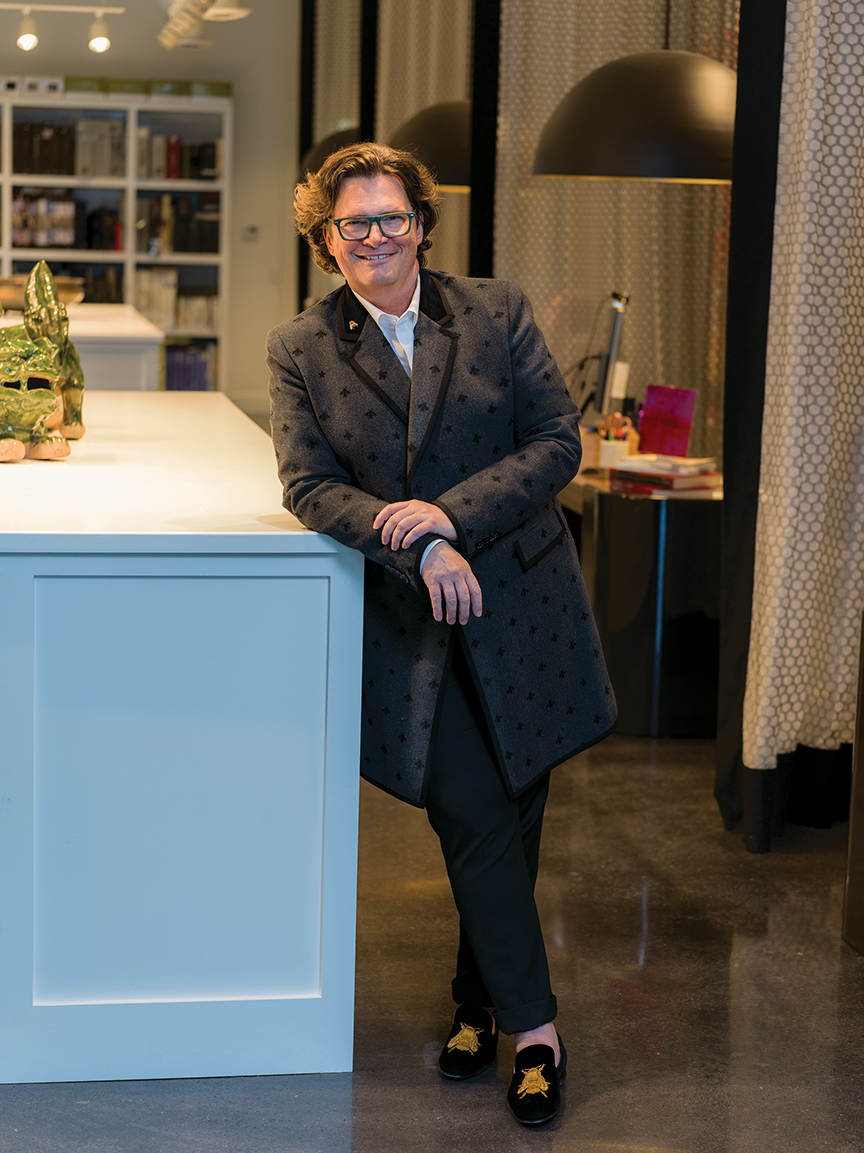
Photos by Mark Jackson/CHROMA Photography.
Designer Chris Goddard grew up in Arkansas in a house full of built-in furniture. As his love for design started early in life, he says this situation “drove me nuts.” Now, as the principal founder of Goddard Design Group, he credits these hurdles, as well as the creative nurturing of his family, for his love of change, which continues to inspire every facet of his work.
It was the need to produce something new every time, and the drive to push himself past his own creative limits, that helped Goddard become a finalist on the most recent season of HGTV’s Design Star: Next Gen.
We spoke with Goddard about his whirlwind experience of creating interior design for TV, and how his reality TV appearance inspired an even deeper love for design than he’d had in 30-plus years.
For those who haven’t watched the latest season of Design Star, can you relay to audiences your method of design?
I’m a big proponent of change, if you’re doing the same thing you did 3 years ago you’re doing something wrong. I never do the same thing twice, so in 30 years we’ve never used the same fabric twice, the same piece of furniture twice — it’s kind of my trademark. I don’t want anybody to have something somebody else has.
What has been your biggest inspiration, since you were young, to work in such a creative field?
I grew up in a very creative family, always surrounded by creativity and the arts. My family, especially my mother and my grandmother, were big on travel and exposing me to as much as possible. So I traveled a lot and spent a lot of time in museums. They would always take me out of school for weeks at a time; they always said ‘the best education was travel and experiencing things.’ I grew up a little globe-trotting kid, seeing the world, which was wonderful and super inspiring.
You received both design and business degrees in college. Have you found this type of structured education helpful as well?
I’ve found that having a business degree really makes a huge difference. Most designers are creative but can’t always run a business, and I’ve been able to strike a good balance. That’s not to say I haven’t ever screwed up — we all have — but those are called learning experiences.
You mentioned loving to travel, what’s one of your favorite places to visit?
One of my favorite places is Morocco. I try and go once a year. I’m super inspired by the colors and textures, anything that’s handmade. When you have something that’s made by hand, at least one thing in your house, it gives your house a soul and gives the room a sense of place, like it’s always been there. That’s my whole deal, creating timeless rooms. I don’t want anything to look like it was stuck in time, and the key to doing that is layering in parts of the past, present and modern so you get something that never really goes out of style.
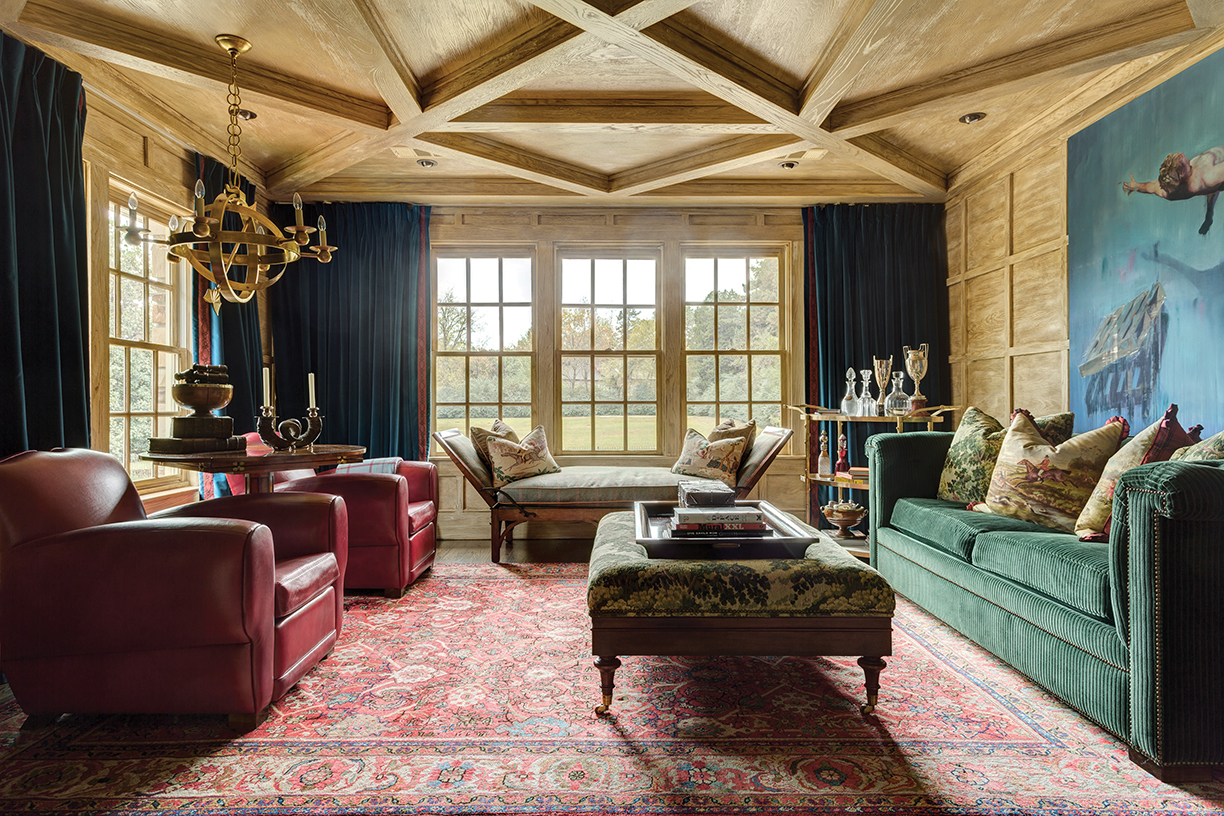
A traditional Southern estate with hints of modern elegance in Fort Smith, Arkansas.
What is your primary focus when you’re designing a space?
I’m designing for the client, or if it’s commercial, for the space. You want to create an experience that is singular to them. I think the death of most design is becoming a trend or doing anything trendy, so I always try to be very specific in what I’m doing and make sure it’s uber-tailored to the space or the client.
I think as a designer the biggest compliment I can ever get is when someone comes in and says “Oh this looks like the homeowner,” instead of “this looks like a Chris Goddard house.” The biggest compliment is that it’s a reflection of the homeowner or the space.
What was it like to be on an HGTV show? Did you enjoy your time on set?
When I started my business I taught myself how to do everything, how to put on wallpaper, how to paint — to be a good designer you have to have an understanding of all the people that work for you. I haven’t done that [in person] in over 25 years, but [on the show] it all came back to me like riding a bike. … Each episode was like a day and a half, so cranking everything out and then being judged on it was a little tricky. In our career, our clients are the judges and you kind of have an idea of what they want, but when you go into things blind, you don’t know.
For me it was more fun because I got to push myself out of my comfort zone, which I really needed. I kind of looked at the whole experience as an opportunity to reignite my passion for design. It’s easy when I get to the level I am at and get comfortable — and I think I was feeling a little comfortable — which was the reason I wanted to compete. Doing it, I came back and I couldn’t have been more excited about design than I had in my whole life. It was the best experience I could have ever had.
What lessons have you taken away from the experience?
It’s best to go with your first thoughts. If you get too much in your head, it throws off the creative process. Don’t be afraid to try anything new. The main thing [I learned], though, was to trust my gut, be authentic and keep pushing myself. And to learn something new. I learned so many new design tips, technology tips — everyone had so many things to share. It was nice to just be able to soak it all in.
How have things progressed since going back to the firm? Any big plans for the future?
I’m excited to see what happens in the next few years, as design is having a Renaissance. Right now we’re busier than ever, since people have been stuck in their homes and they see things they want to change. They want multifunctional spaces, beautiful spaces, there’s been this huge resurgence in an interest in design. The whole world is once again interested in how they live.
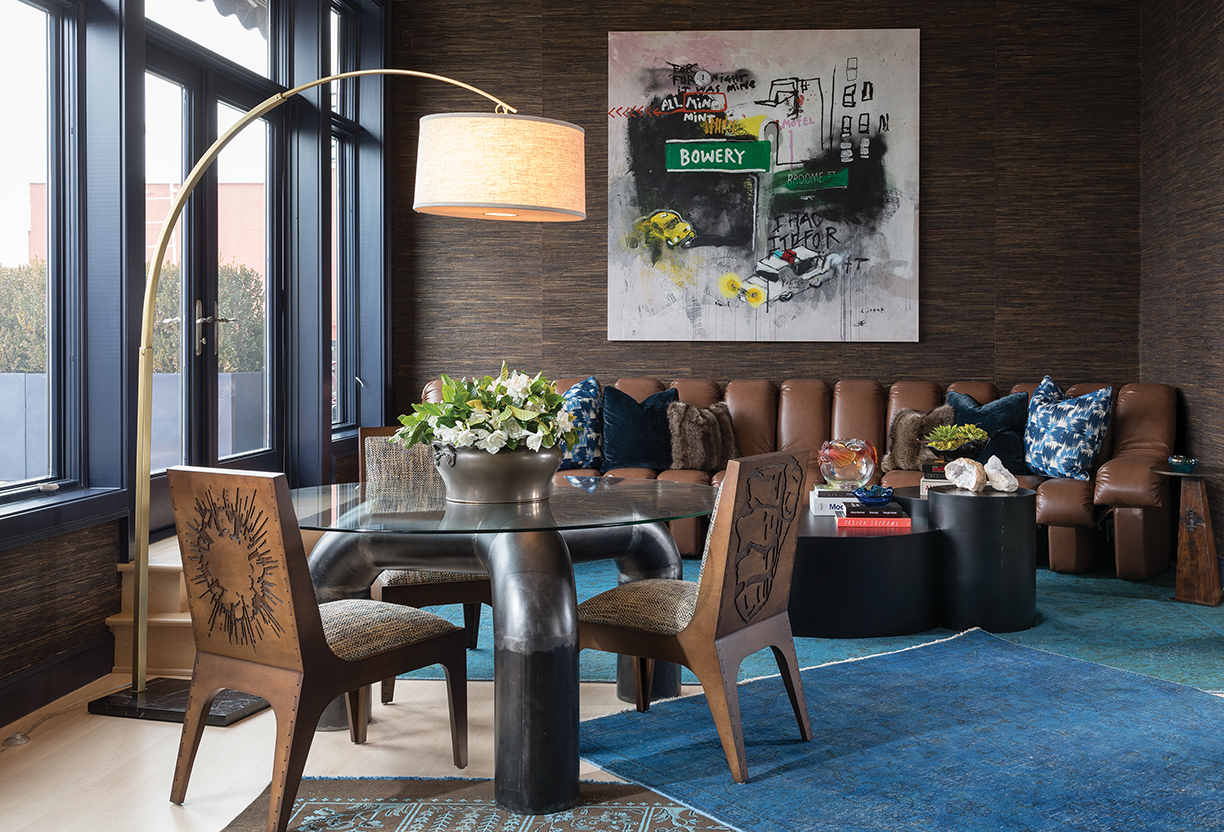
The design style of this home evolved from Spanish Mission into an eclectic mixture of modernism and neoclassical, created through thoughtfully curated collections, from vintage Chinese rugs to contemporary art.

A key component to the design of this Fayetteville penthouse was the incorporation of pieces from the client’s extensive modern art collection, seen above and below. “It was a lot of fun to pull modern furniture and art together to create a new space that still resonates our client’s unique, eclectic personality,” according to Goddard Design Group.
Top photo by Rett Peek Photography.
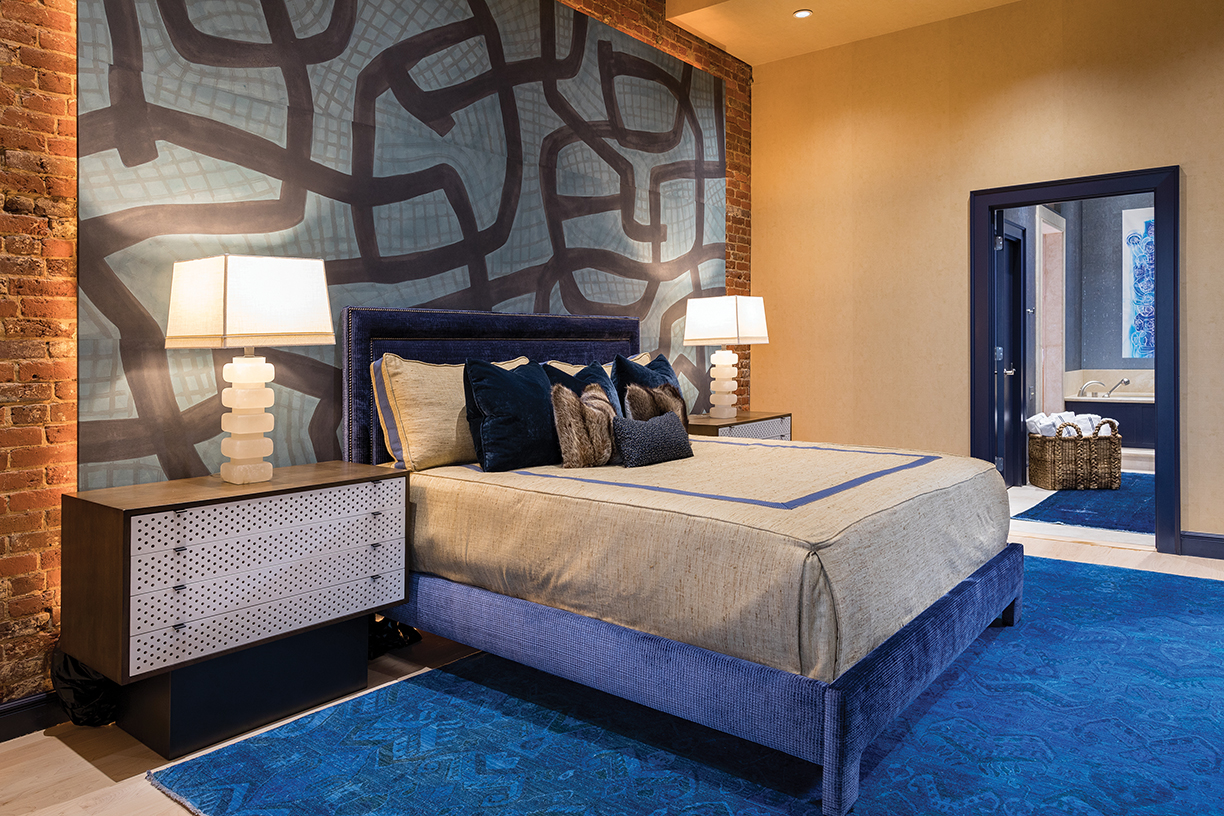
Cover photo by Scott Selzer.
Customized pergolas bring the best of the indoors out — whether used as an airy yoga studio, home theater, or al fresco living space.
The pergola, an outdoor structure with support beams and a decorative roof design, is a great way to extend living space and increase the amount of time spent outdoors. Providing shade on a hot day, pergolas are traditionally associated with entertaining in the spring, summer or fall. Now, one company’s personalized, high-tech pergola with a fire pit, hanging heaters, and retractable, vinyl screens can extend the outdoor season into Northern winters as well.
StruXure creates custom exterior pergolas with wind, rain, snow, and freeze sensors that automatically activate the pergola to open, close, pivot, and slide. CEO and Chief Product Architect Scott Selzer was a middle school teacher working part time in construction, until he discovered a niche market in the construction industry — the pivoting louvered-roof structure that could be controlled and customized by its users.
The system can be operated through voice commands by integrating technology such as Amazon’s Alexa and Google Assistant. “You’re in control of the weather instead of the weather being in control of you,” Selzer says.
When the weather is warm, the screens will open to allow fresh air to fill the space. The louvers pivot 170 degrees; open and close the louvers as the sun shifts in the sky to ensure maximum comfort.
“Bringing the indoors out can change the way you live,” Selzer says. “The Pergola X and Cabana X serve as an extension of the home, making it possible to spend more of your life outdoors.”
“To me, a pergola is a really cool, personal space,” Seltzer adds. “I’ll go under my Pergola X with my laptop and it’s a great place to get work done.”
Made from fully extruded aluminum, the structure can be used as a home office, outdoor kitchen, workout area, or an additional living or dining space. Selzer has even created an outdoor home theater, complete with motorized screens, an integrated projector, and stadium seating. “I’ve seen it all,” he says. “If you can think it, you can do it.”
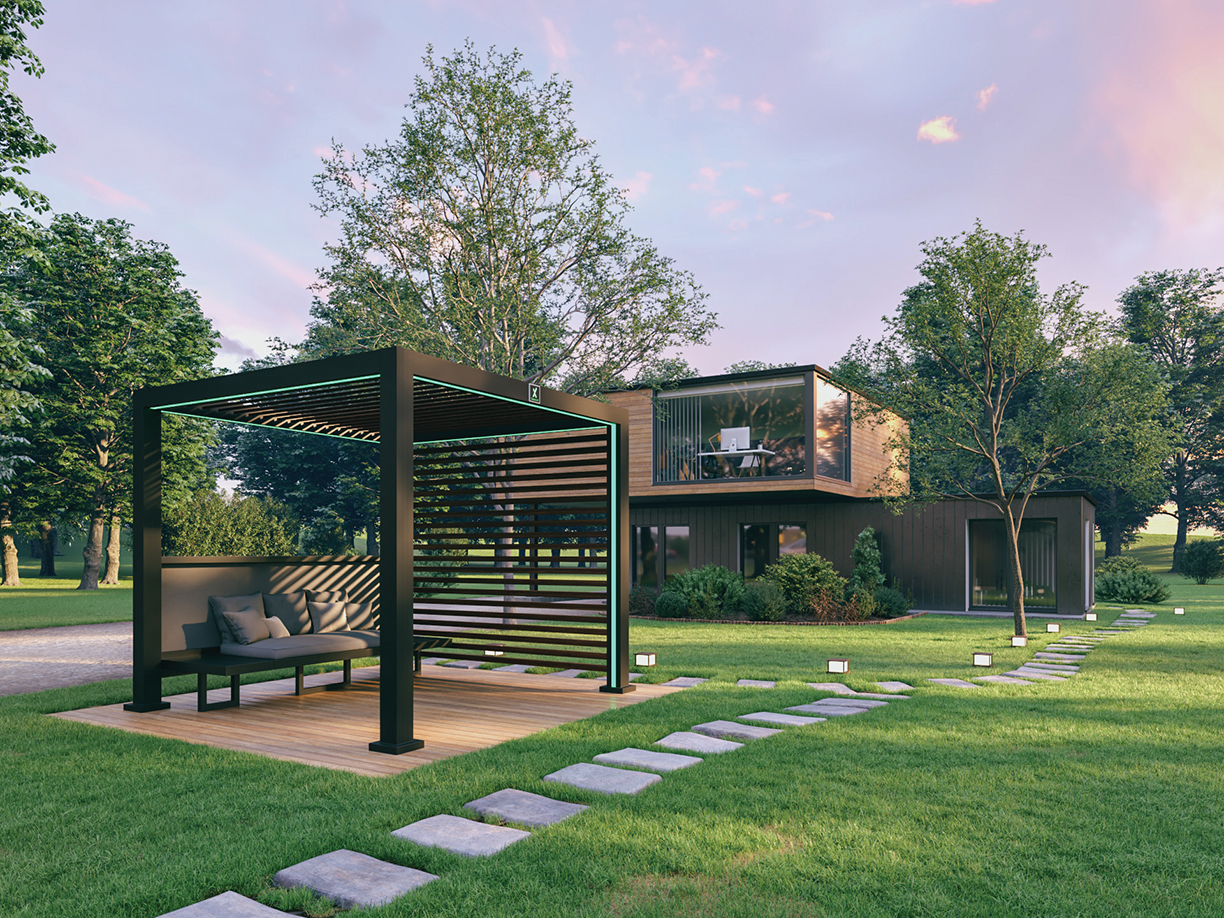
The Cabana X is a freestanding structure that can be taken down at any time and does not need to be professionally installed.
Photo courtesy of Cabana X.
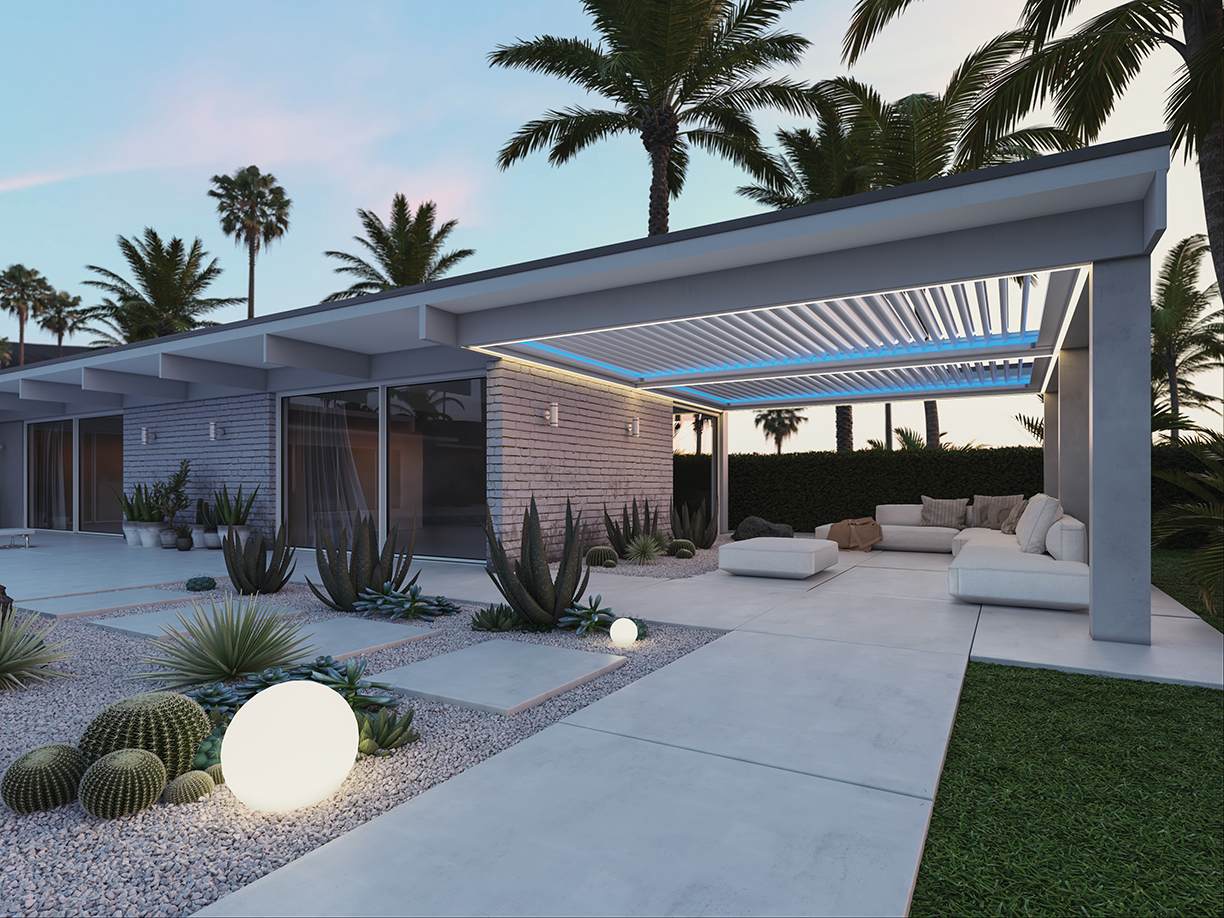
The TraX system allows shades, screens, and lights to be seamlessly integrated into the anatomy of the pergola.
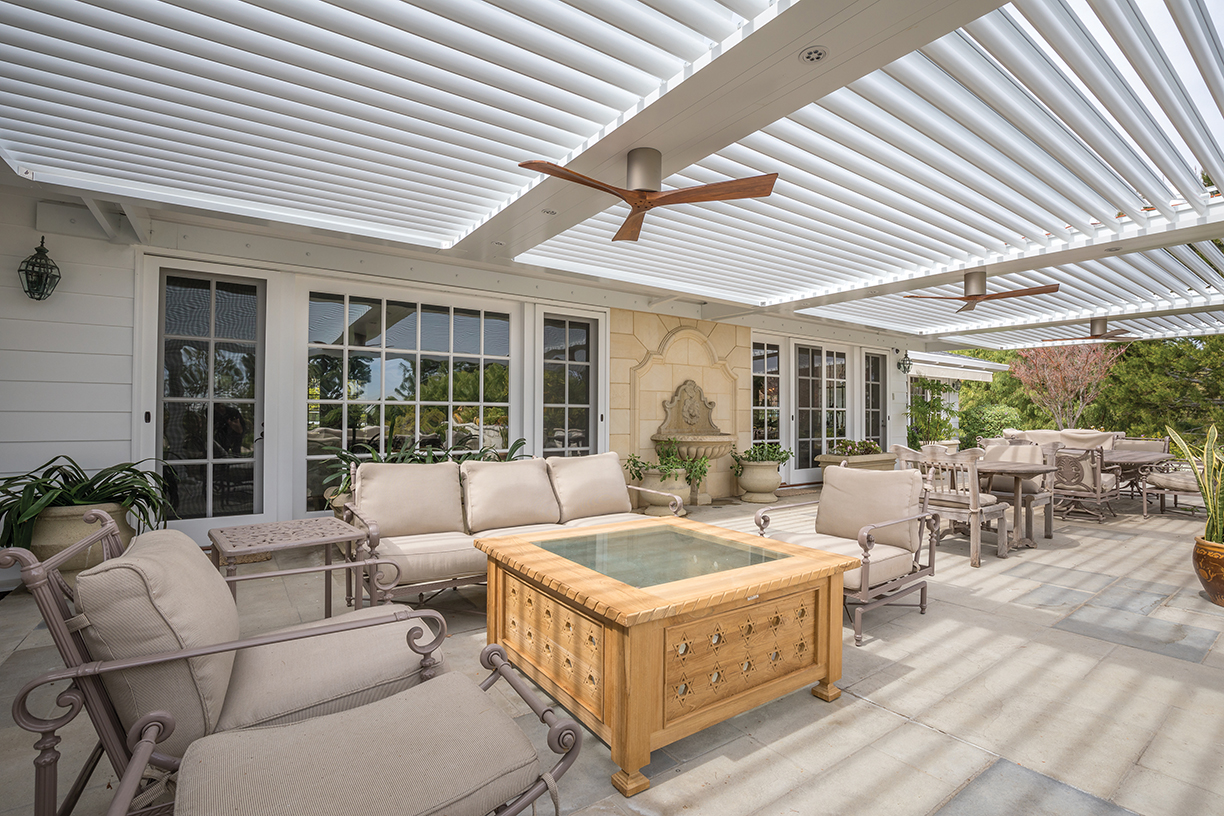
From small patios to large decks, the Pergola X can be a great addition to any outdoor space. This structure was built to open, close, pivot, and slide at the touch of a button.
Photos by Shaye Price.
The TraX system allows shades, screens, and lights to be seamlessly integrated into the anatomy of the pergola. Clients can incorporate curtains, speakers, and ceiling fans as well.
Pergolas can be customized to match any architectural style to ensure the structure will blend effortlessly with the rest of the property. Add corbel ends for a more traditional look, or wrap the columns with rough cut cedar for a rustic, woodsy design.
“By itself, the pergolas look super modern, but you can really customize the product to look like it fits right into any aesthetic,” says Selzer.
When asked what advice he’d offer first-time buyers, Selzer says, “I would challenge homeowners, designers, and architects to think about how the structure will function in the backyard and how the homeowner will live in and use the space. Before the structure is built, consider the accessories that you’ll want — such as motorized screens, heaters, and misting systems. Then, uniquely design the pergola to meet those needs.”

Photo by Rick Chaffiotte Photography.
Interior Designer Marissa Stokes aims for designs that are classic and timeless. And says don’t overlook the ceiling.
For designer Marissa Stokes, home has been a variety of places. Home was growing up in New Jersey, where creative parents and a need for change led to an intense love for interior design at a young age. Home was also New York, where she earned a degree from Parsons School of Design and worked her first jobs at elite design firms, including David Kleinberg Design Associates, Victoria Hagan Interiors and Jayne Design Studio. And now as an accomplished designer, home is more than just a place — it’s every threshold she passes, every piece of furniture she chooses, every decision she makes in order to help craft the perfect space for her clients. We spoke with Stokes about her experiences in the industry and how her love of interior design has transformed her career so far.
How do you think living in New York affected your design style and preferences?
You’re just exposed to so many amazing things, being in and around New York City. The architecture alone, having incredible museums at your fingertips. I also went to school in NYC; I think that was an incredible experience, but also had a huge influence on my design aesthetic, just having everything at your fingertips, between different cultures, food, architecture. I feel fortunate to have lived there and so close to there still now. I love New York City.
When was the first time that you ever thought about working in design?
I really have always wanted to be an interior designer from a very young age.… I think it’s because my parents are both very creative people, always doing things to improve our home.… My dad made furniture, we even had a woodshop in our basement. I just had this love for transforming spaces and the process, and I just fell into it very naturally.
Did you learn wood craftsmanship yourself?
Yes! I had all the tools at my fingertips in the shop, and I am still able to use them now, a bandsaw, a tablesaw, et cetera. We also had a sewing machine, so I grew up sewing at a young age — we’d be making window treatments and pillows. I was always transforming my personal space, shifting things around, changing them or painting them. Making them look different. It was just something I always loved to do, and still love it.
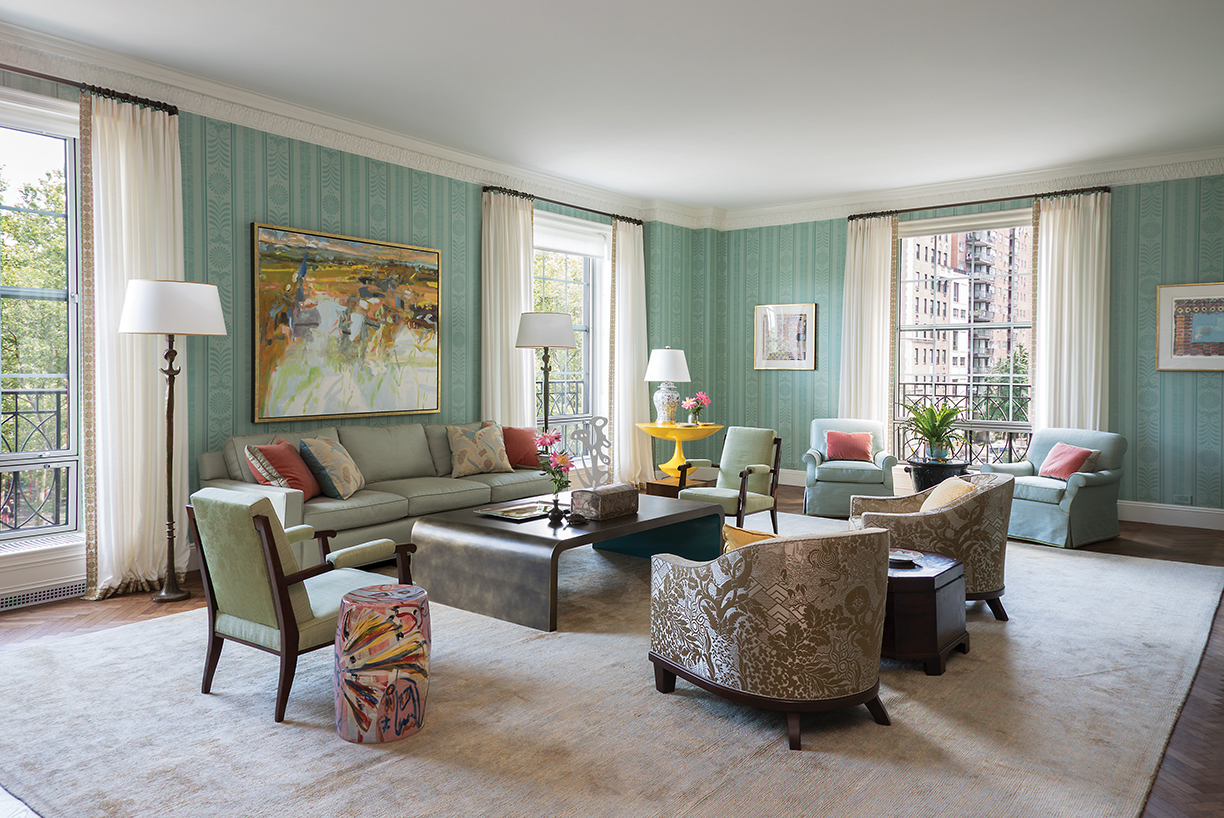
A bright living room situated in an Upper East Side apartment.
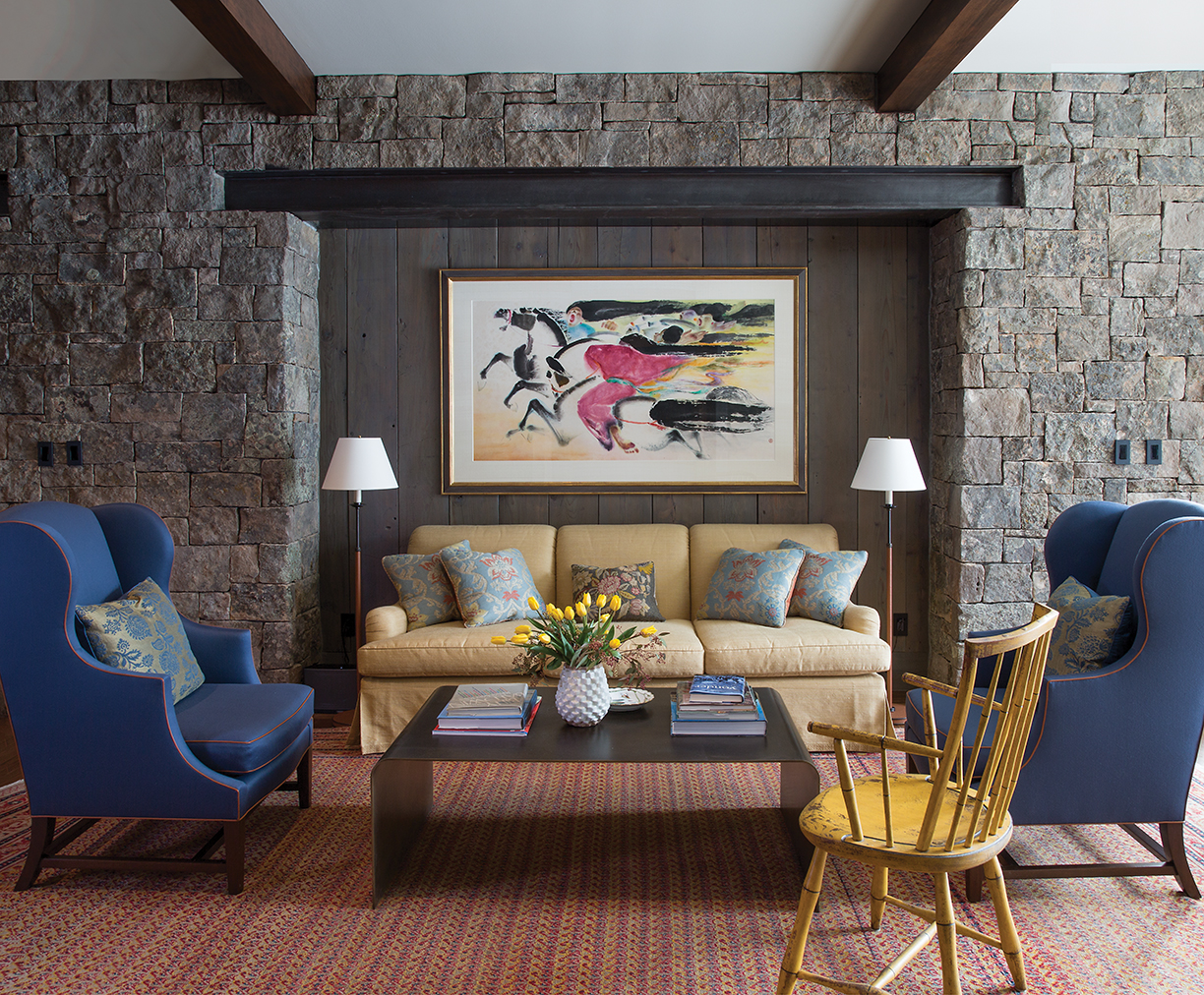
The corner of a library in a Montana lodge.
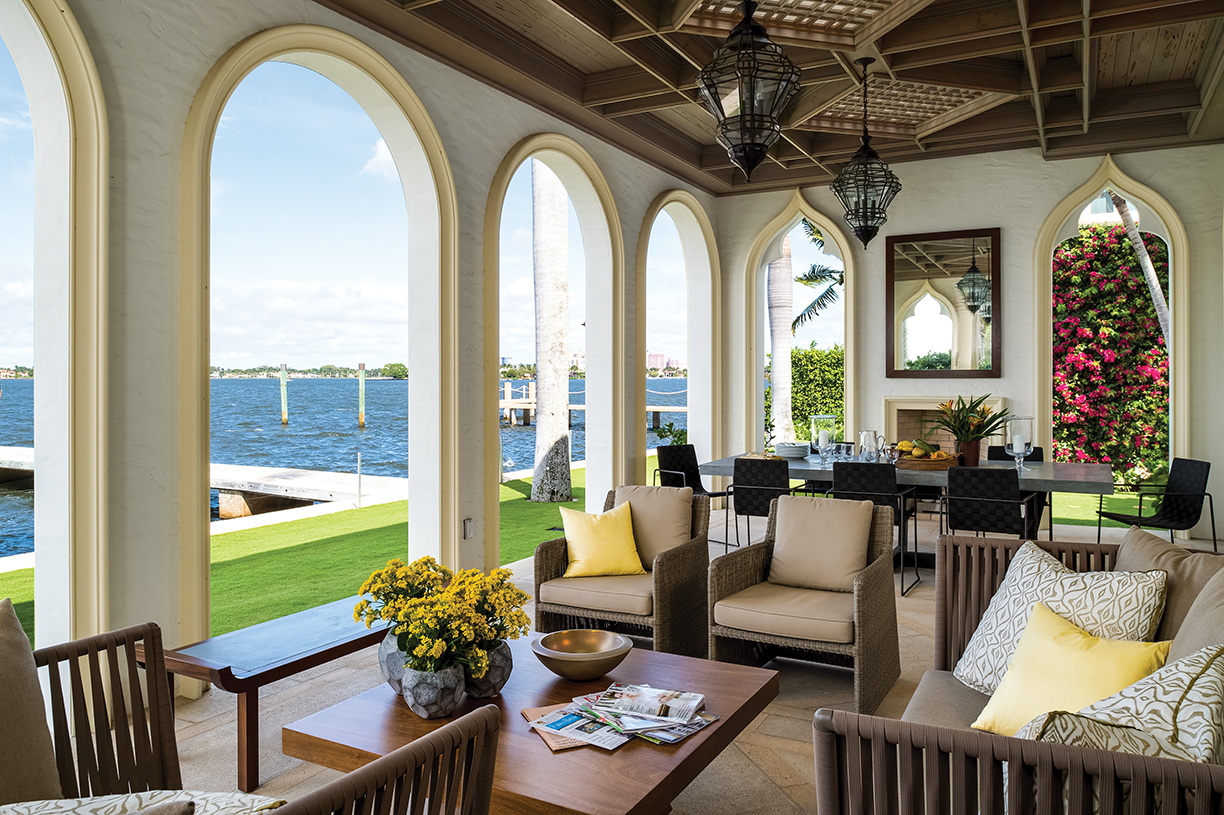
A Mediterranean Revival home on the Intracoastal in Palm Beach.
Above photos courtesy of Jayne Design Studio.
Why do you do what you do, what about art and design draws you into doing it every day?
I love making people’s dreams come true. There’s something so rewarding about helping a client transform their space so it’s not only functional, but beautiful. In terms of art and design, there’s so many artists and creatives out there who are doing incredible work, and I’m being exposed to them, just learning and growing. It’s another reason why I love what I do. Every day is different and I just love that.
Are there any activities outside of work that help inspire you or your work?
Outside of work, I’m always trying to get out in nature, go for a walk or hike — nature is always inspiring. I feel like I can always pull things from that. I love to travel as well, even though it’s been a bit difficult to do so.
Where’s somewhere you love or would love to go?
My dream place I’d love to go is Greece. It really offers everything. It has ancient and historical sights, of course, but also beautiful landscapes and amazing food.
What has been your favorite project to do?
I worked on a project for Jayne Design Studio in Palm Beach. It was my first project as a senior designer for the firm. It’s a Venetian-inspired home on the Intracoastal. The clients were art collectors who wanted to enjoy the views and display their art. We designed and decorated a home that was quiet, clean and sophisticated to balance their collection and the architecture. I loved the home, its location and the clients. I will always have a soft spot for it.
When it comes to designing, what is the most important element you have to remember?
Well one thing that tends to be overlooked, I think, is the ceiling. It’s very important to design from top to bottom, to think about ceiling work, a lighting plan, and overall how it’s treated and how it affects the space.
Is there a piece of art in your own home that you would never consider selling?
Everything is here for a reason, so not one specific piece.
It’s always important to surround yourself with things you love, even if it’s a bit eclectic, surround yourself with furniture and art that you love. When you do that, things just kind of work together. There’s no standard.
What do you want people to take away when they look at your work?
I want people to find it classic and timeless, something that could last forever. I don’t want someone to walk into a space and instantly date it. I want the clients to be comfortable in their home for a long time. Keep things sophisticated.
What advice would you give to someone going into design?
Don’t be afraid to roll up your sleeves, you have to wear a lot of hats in this industry. Maybe start with an internship, but, all in all, do whatever you need to do to learn.
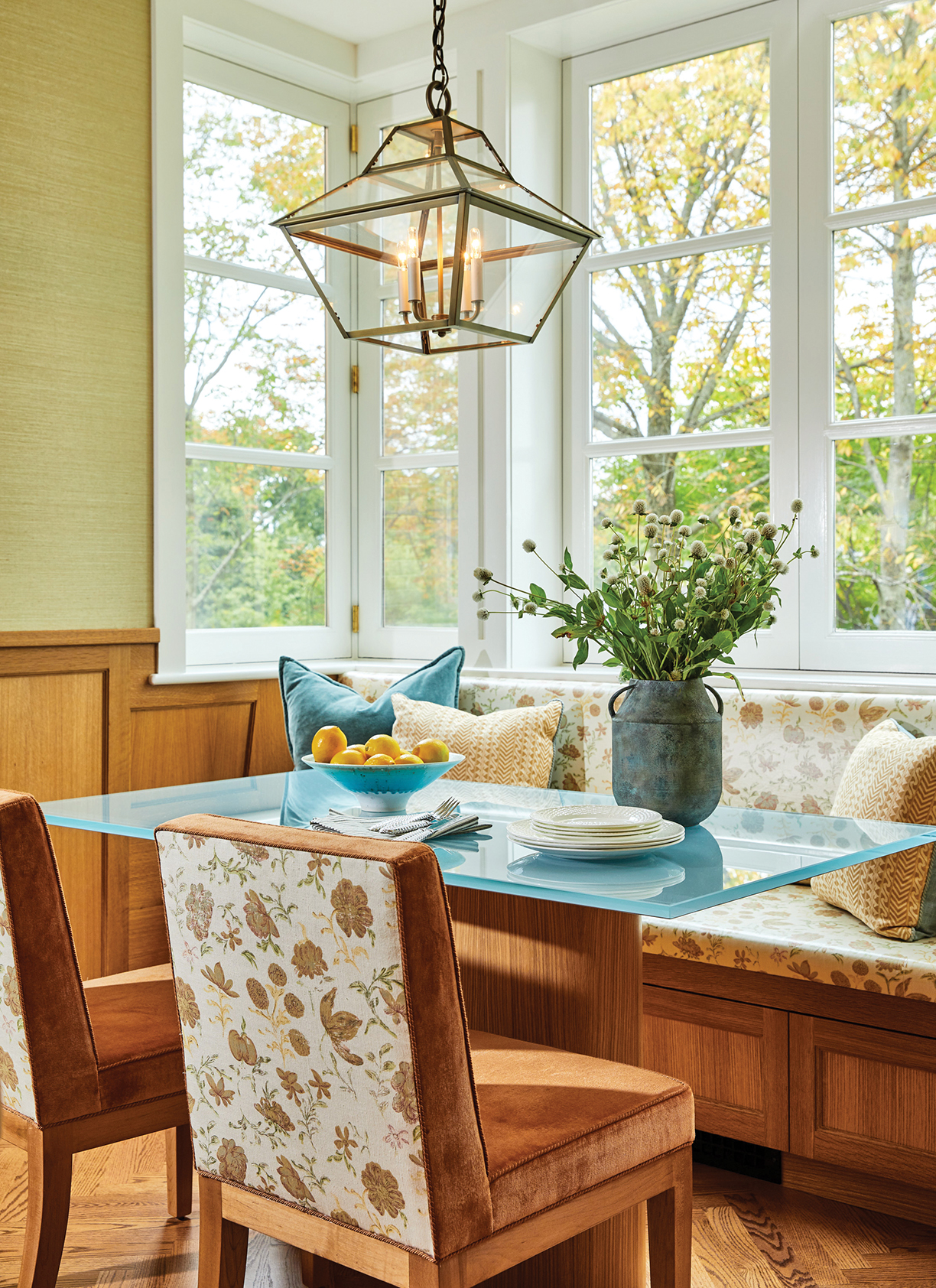
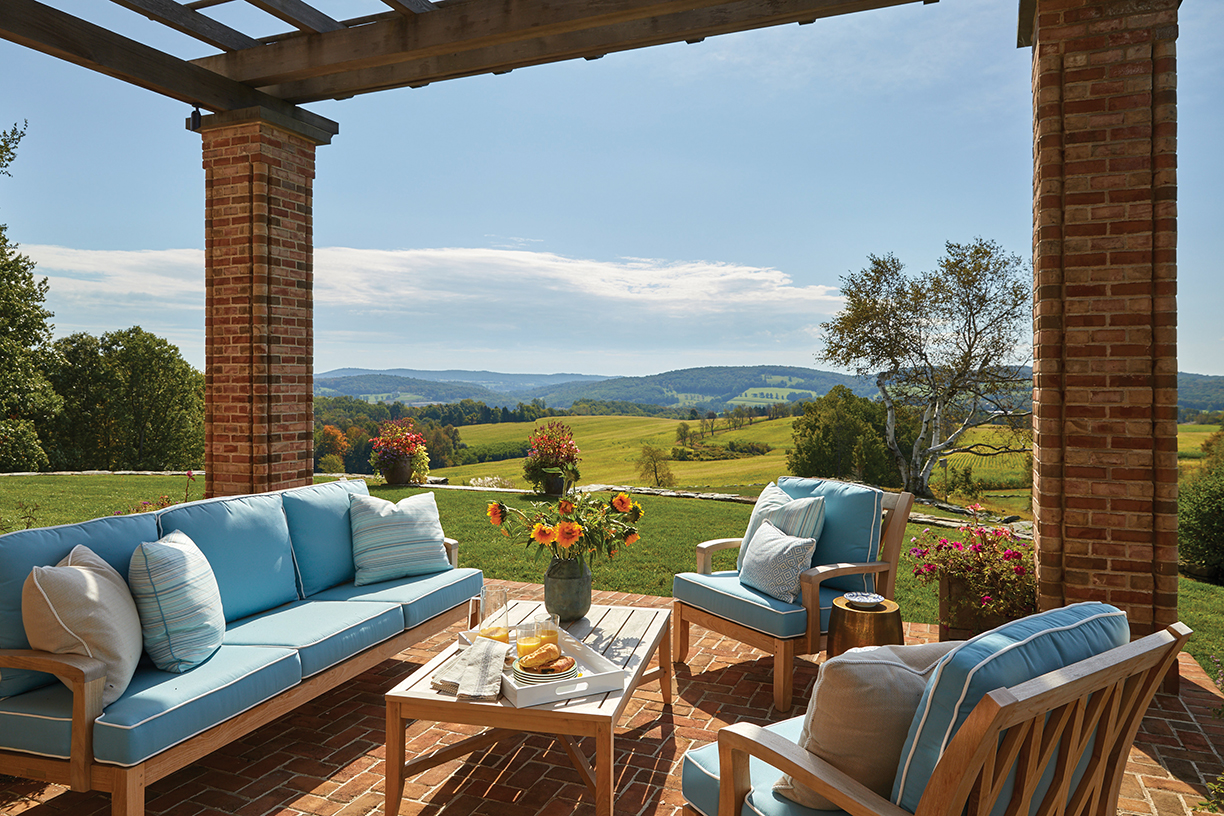
At left: A cozy breakfast room nook with a custom-designed banquette. Photo by Aaron Thompson.
Above: An outdoor terrace overlooks Dutchess County. Photo by Aaron Thompson.
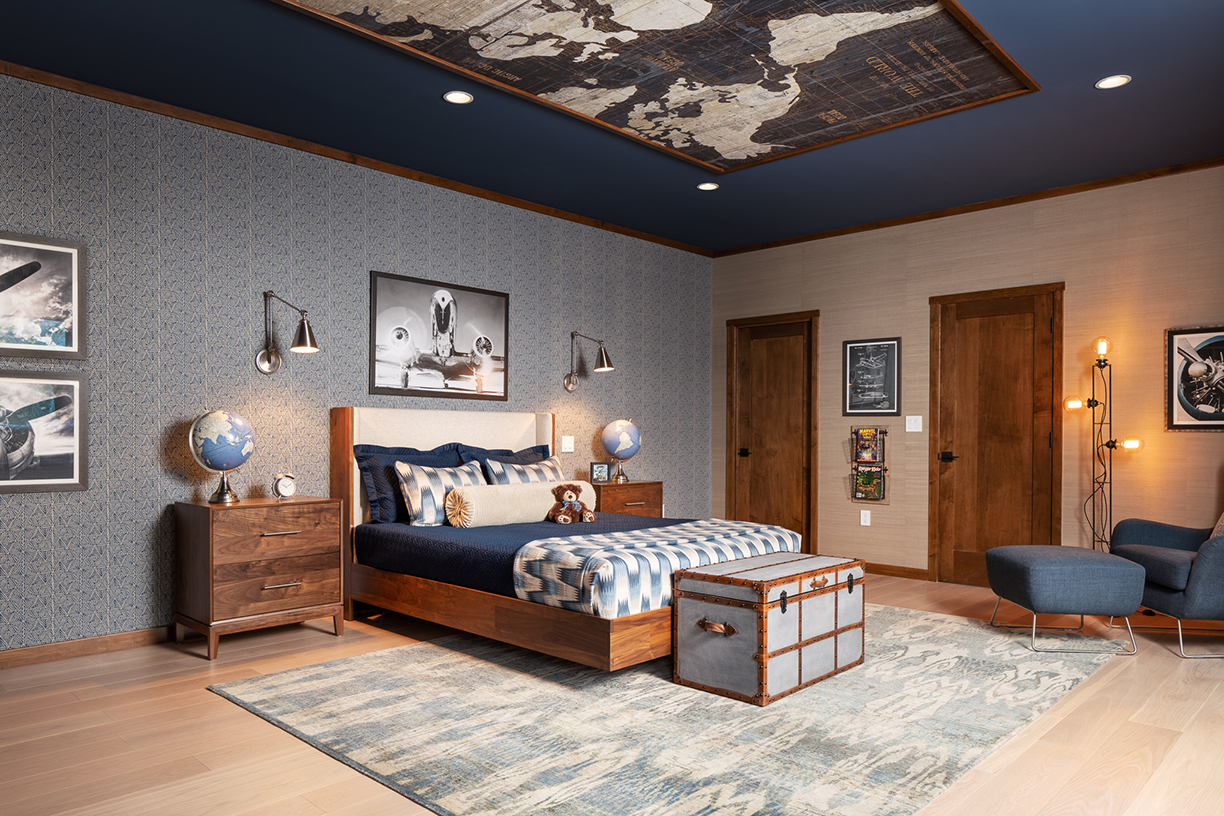
Designer Diane Durocher quoted “Adventure, curiosity and exploration are what opens young minds to infinite possibilities” as the inspiration for the boy’s bedroom in the home. Choosing a color palette and furniture to grow with the child, Durocher explains the room represents a child’s curiosity about world, travel and life. Featuring an en suite bath, the bedroom is the perfect space for growing and learning.
Designer ~ Diane Durocher ASID, IIDA, CAPS, CID
Diane Durocher Interiors
201.825.3832
diane@dianedurocherinteriors.com
dianedurocherinteriors.com
Instagram ~ @diane_durocher_interiors
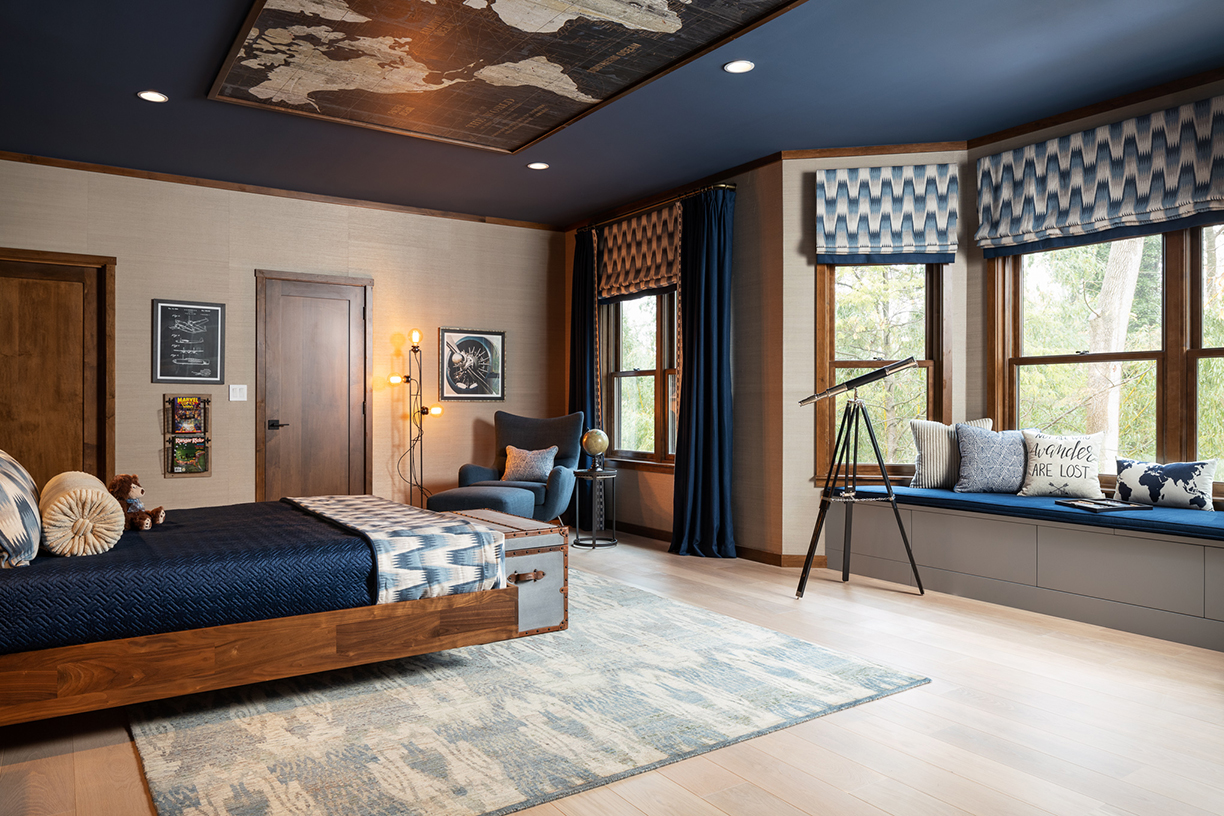
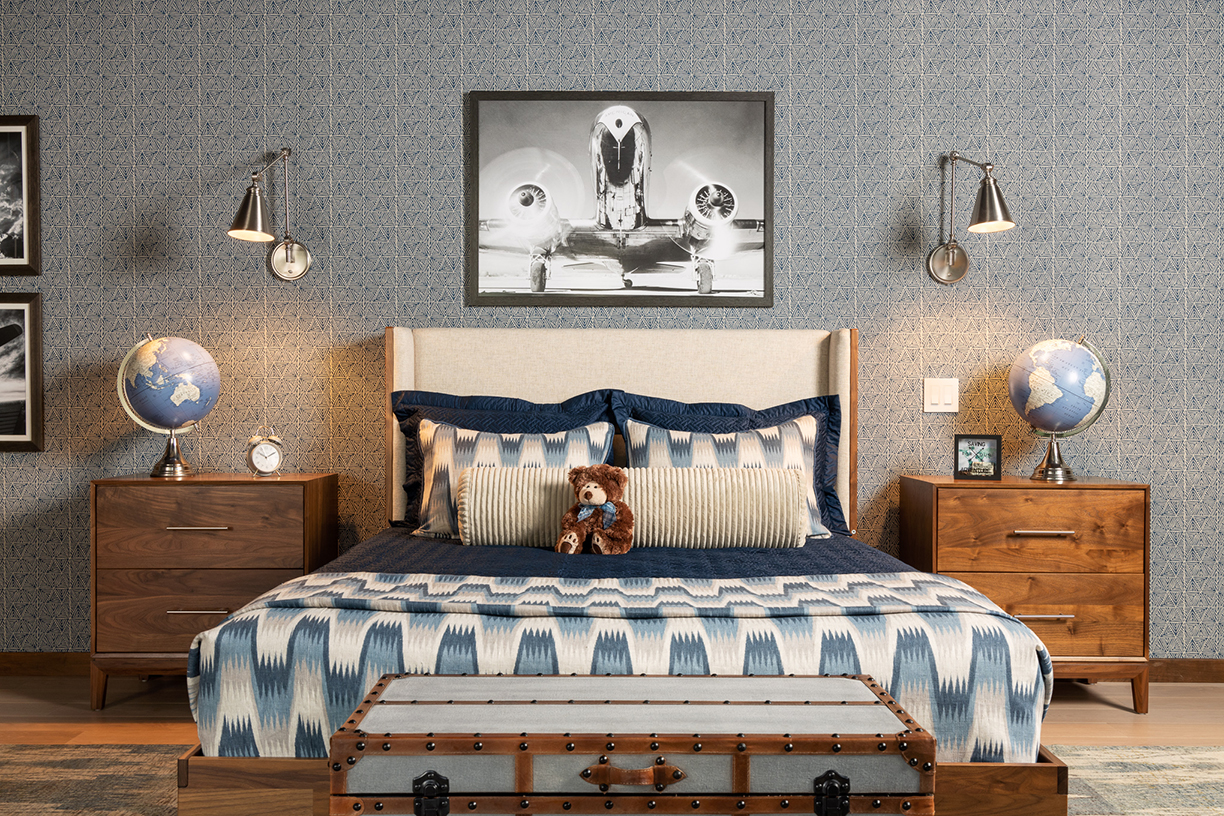
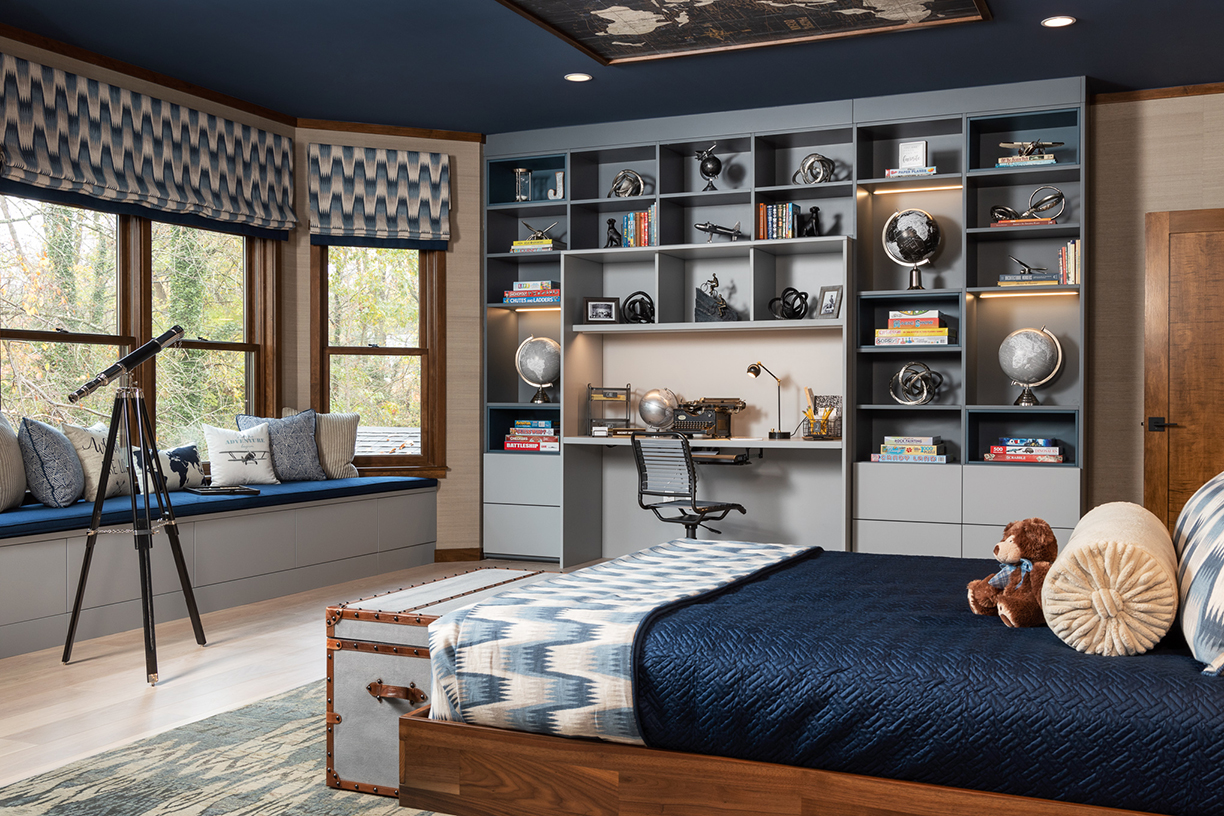
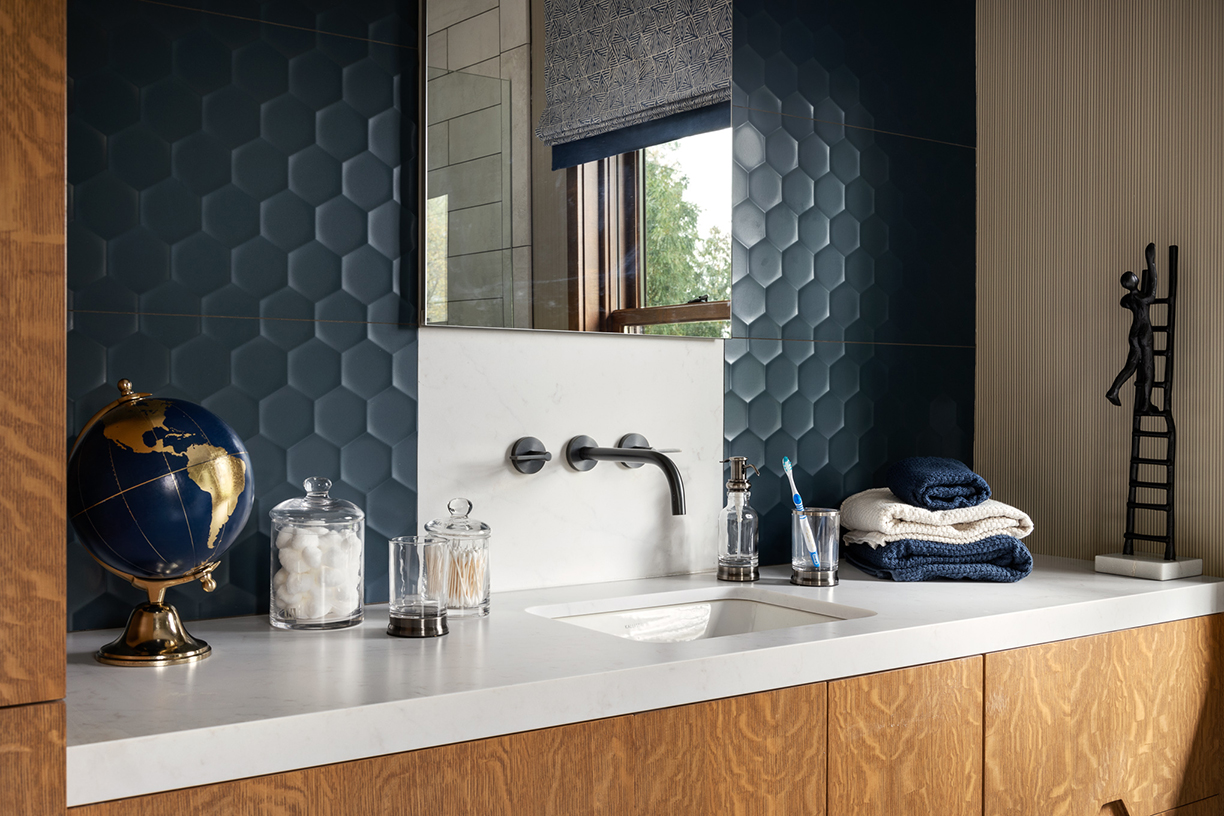
Photography by Mike Von Tassell Photography
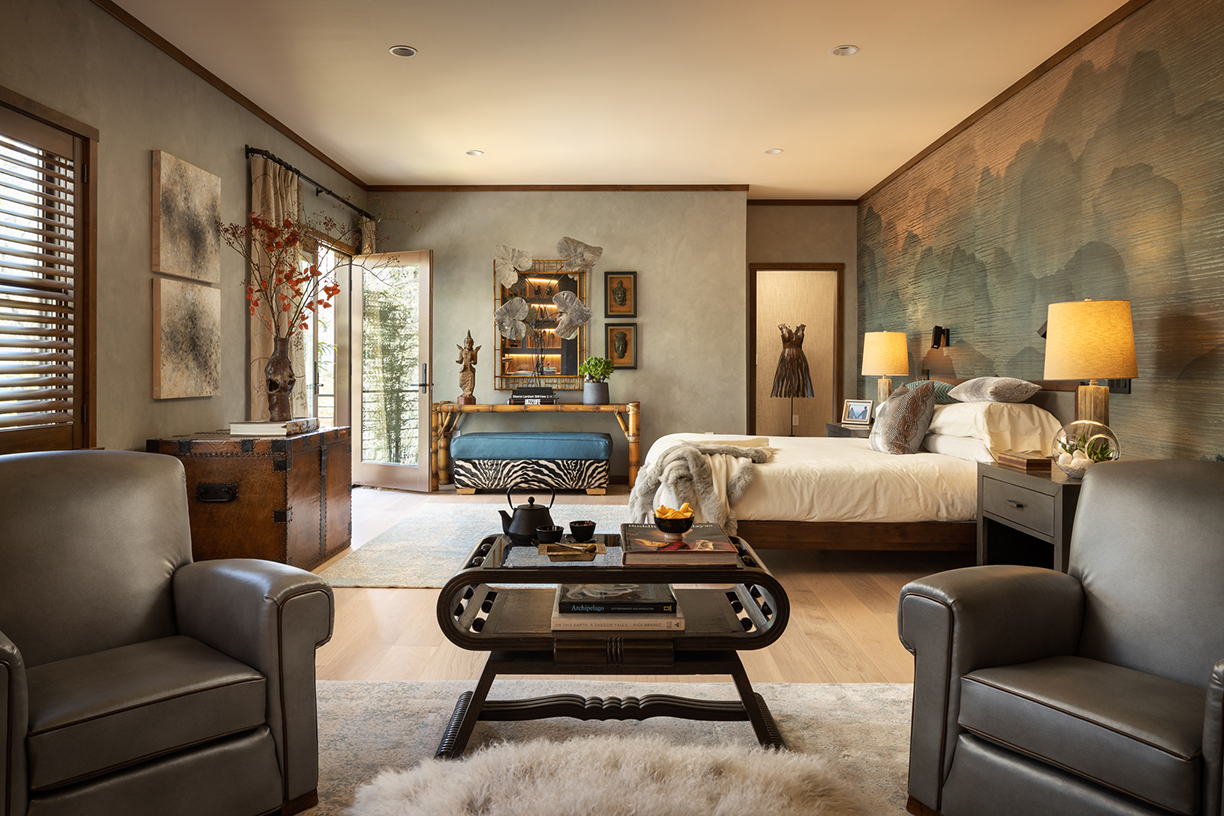
This zen master suite is the perfect space to unwind or start the day, with an impressive master bath, spacious walk-in closet, and distinguished furnishings. A soft mural wall and striking full-wall fireplace create warming ambiance in the space, highlighting comfort and opulence.
For more information on the ASPIRE House Princeton Designer Show House, click here.
Designer ~ Judy King
Judy King Interiors
609.279.0440
info@judykinginteriors.com
judykinginteriors.com
Instagram ~ @judykinginteriors
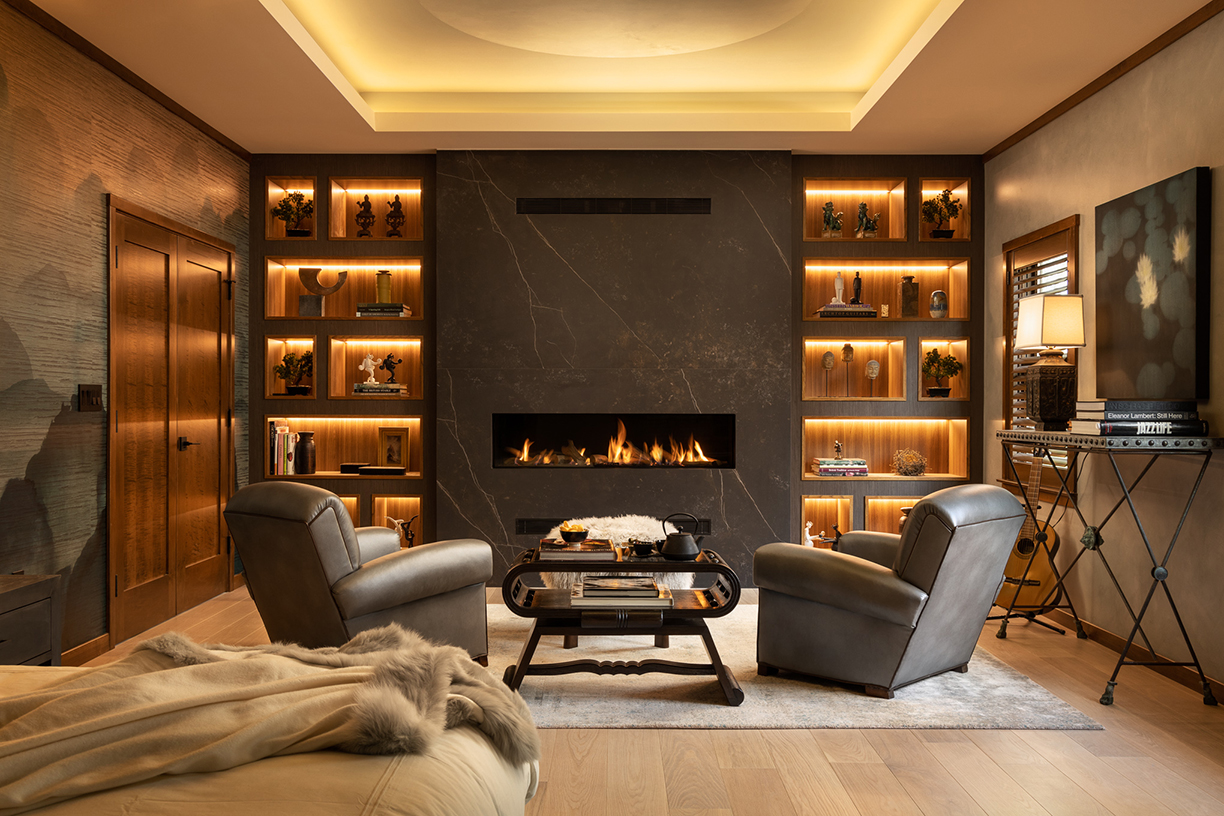
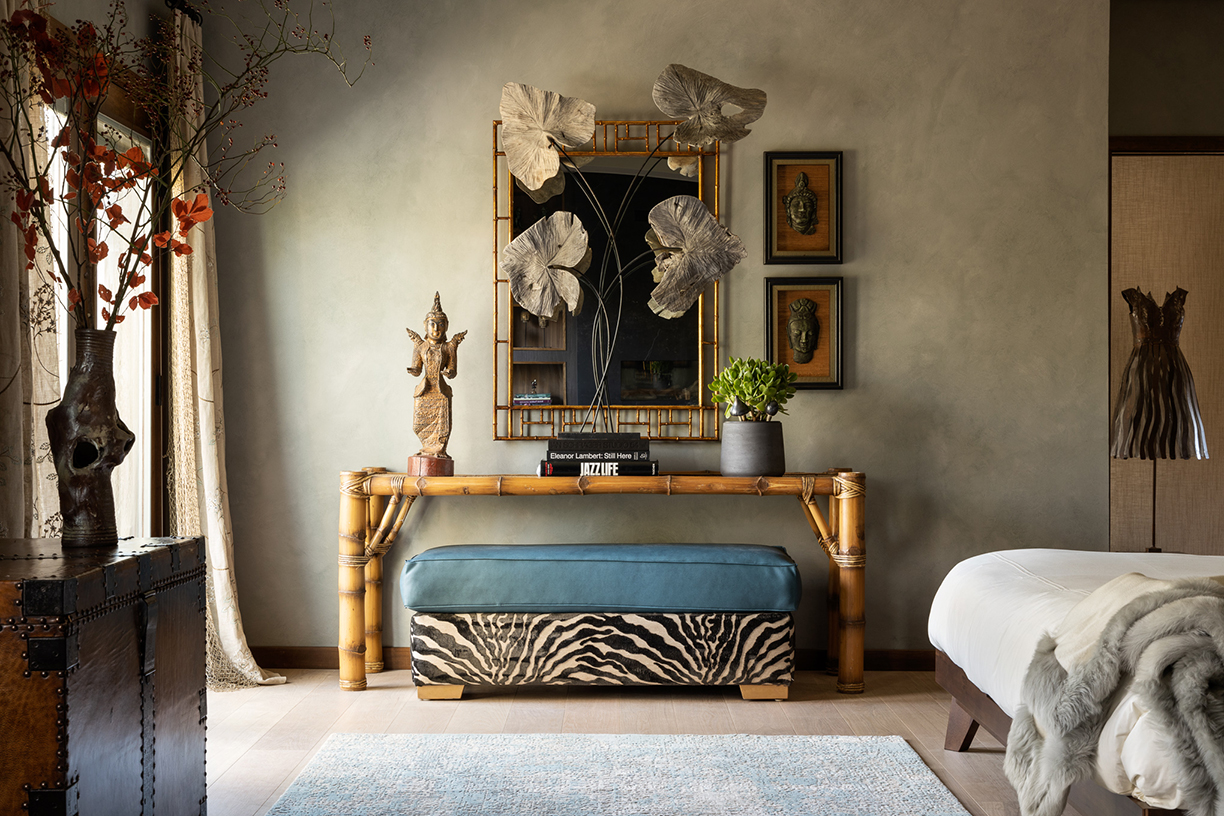
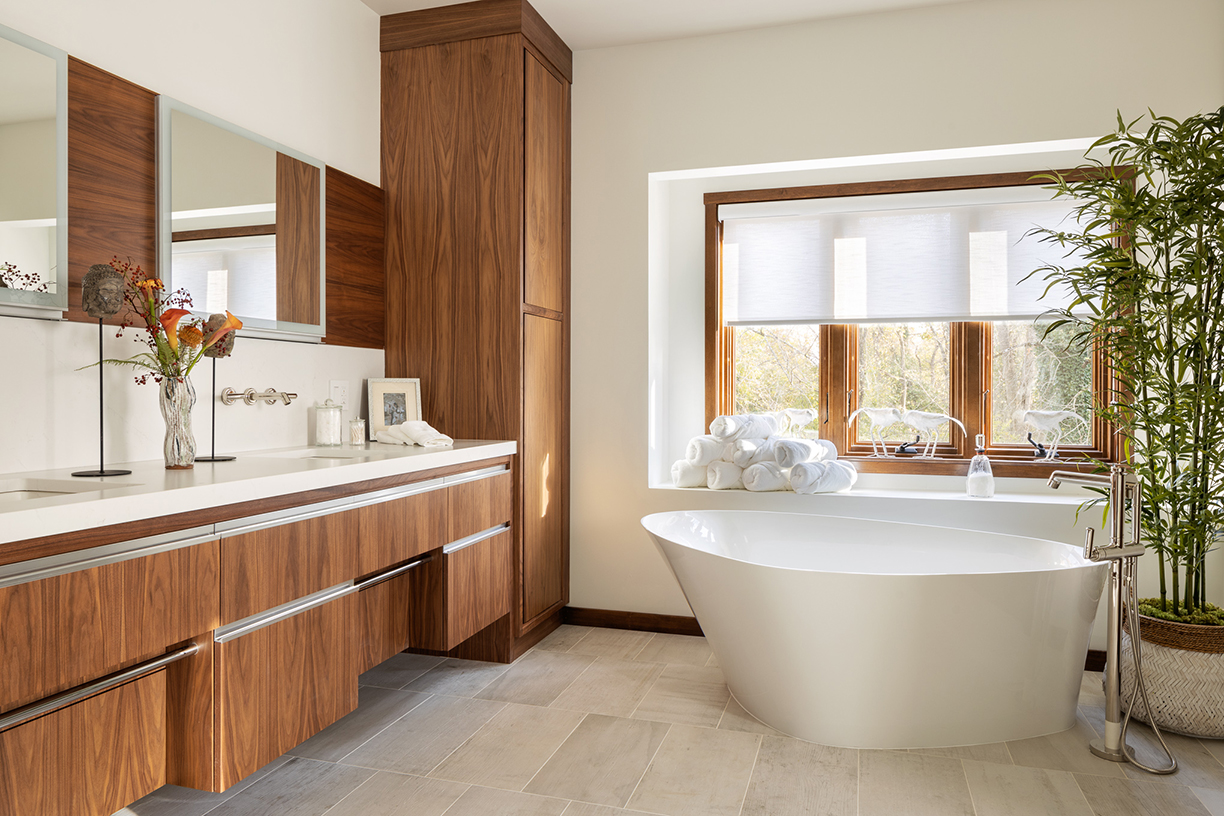
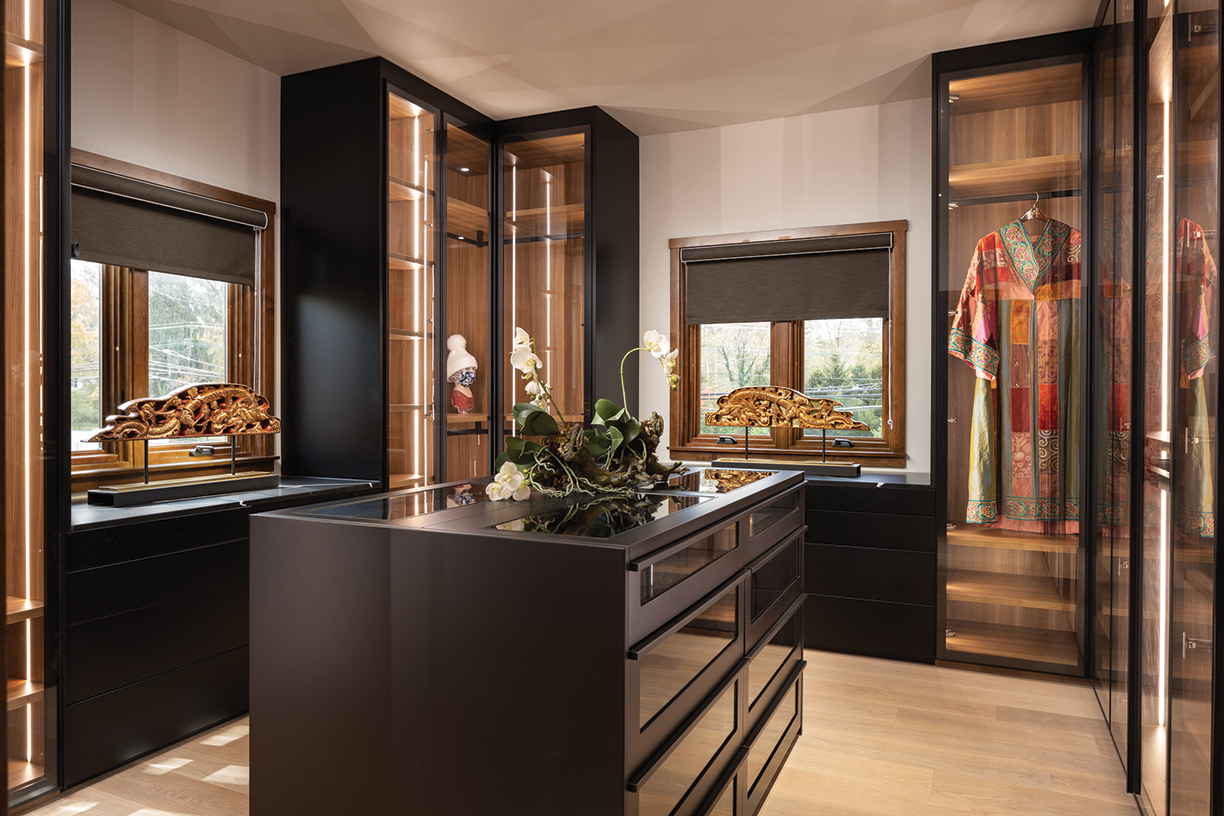
Photography by Mike Von Tassell Photography
This gorgeous great room is the gathering space of the home with the floating fireplace as its centerpiece. Featuring art from the Chelsea Art Group in New York City, the great room is warm and inviting and flows seamlessly into the kitchen and breakfast area.
Designer ~ Anna Maria Mannarino
Mannarino Designs, Inc.
866.574.3326
Holmdel, NJ
mannarinodesigns@comcast.net
mannarinodesigns.com
Instagram ~ @mannarinoannamaria
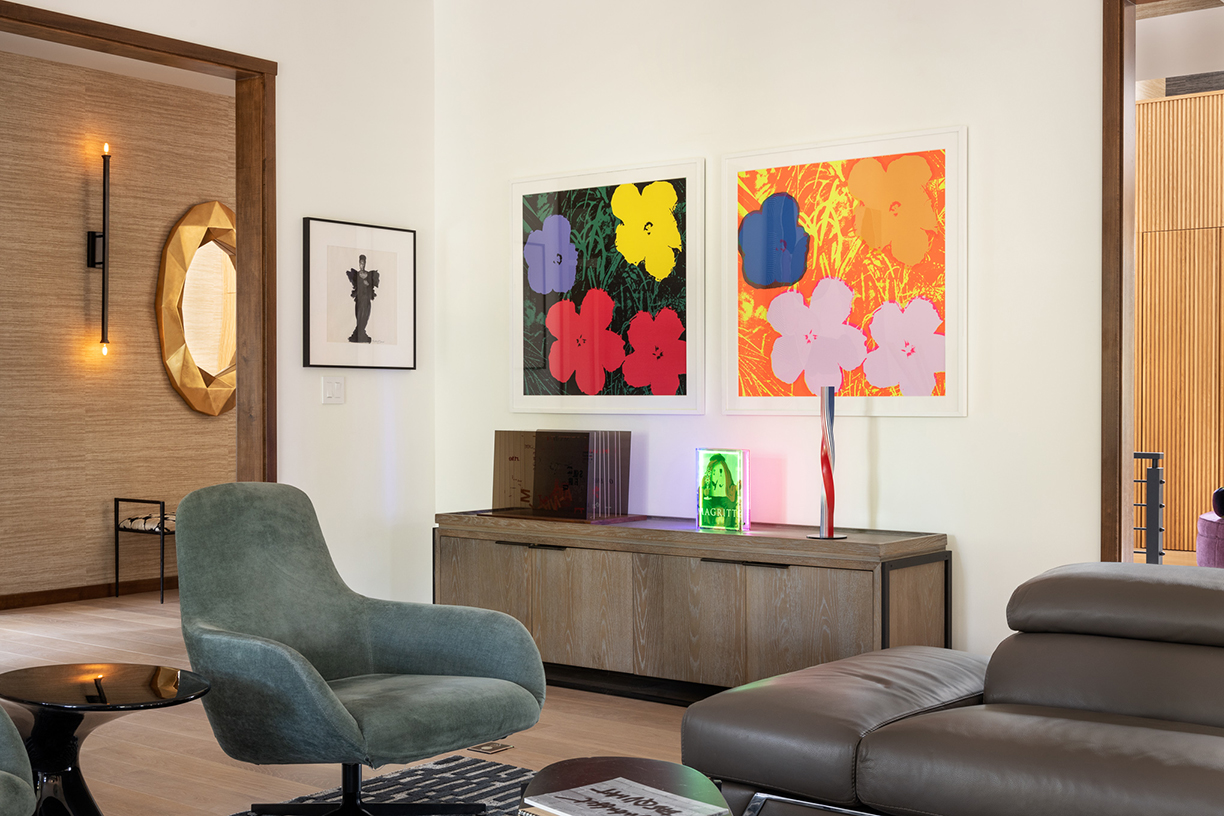
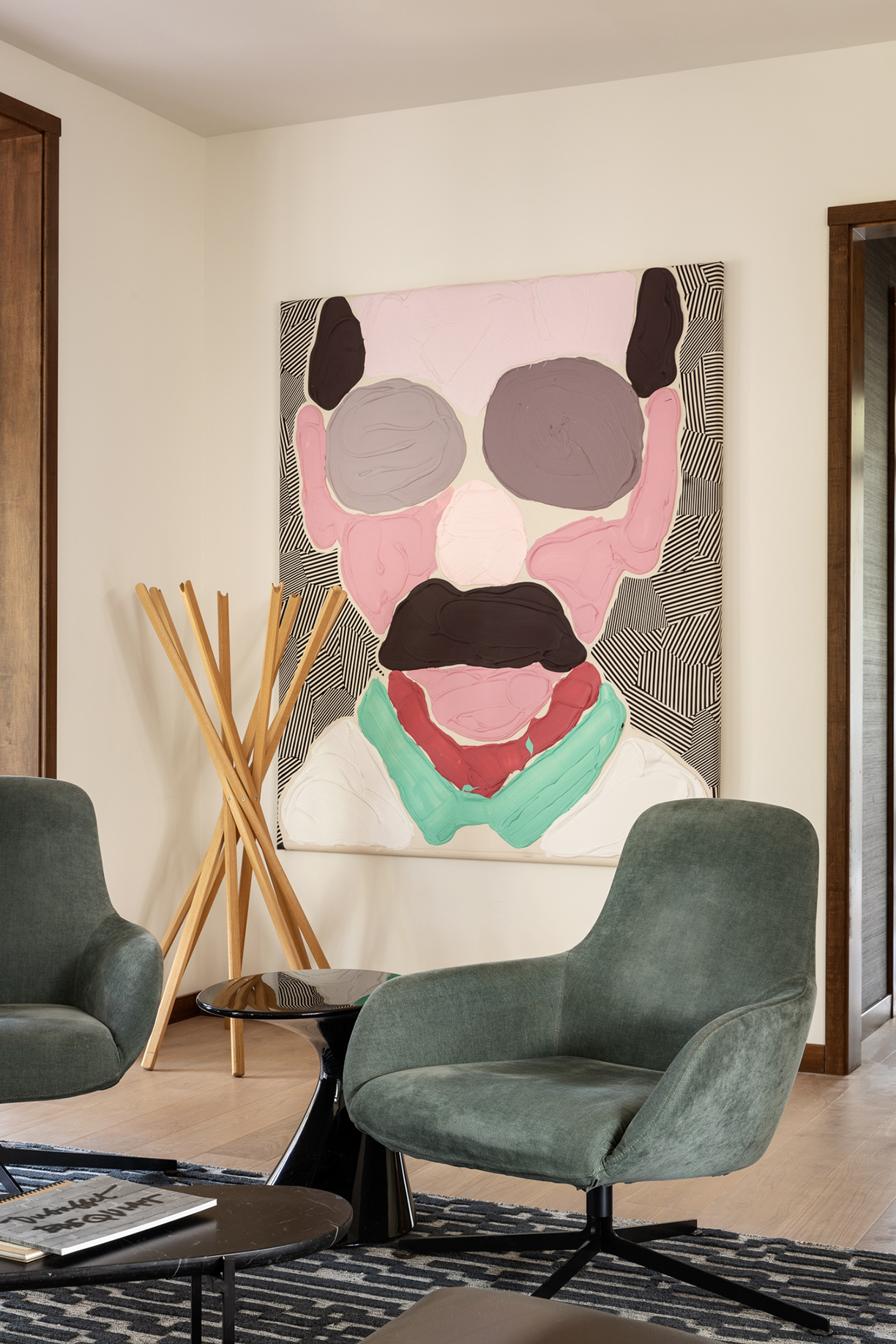
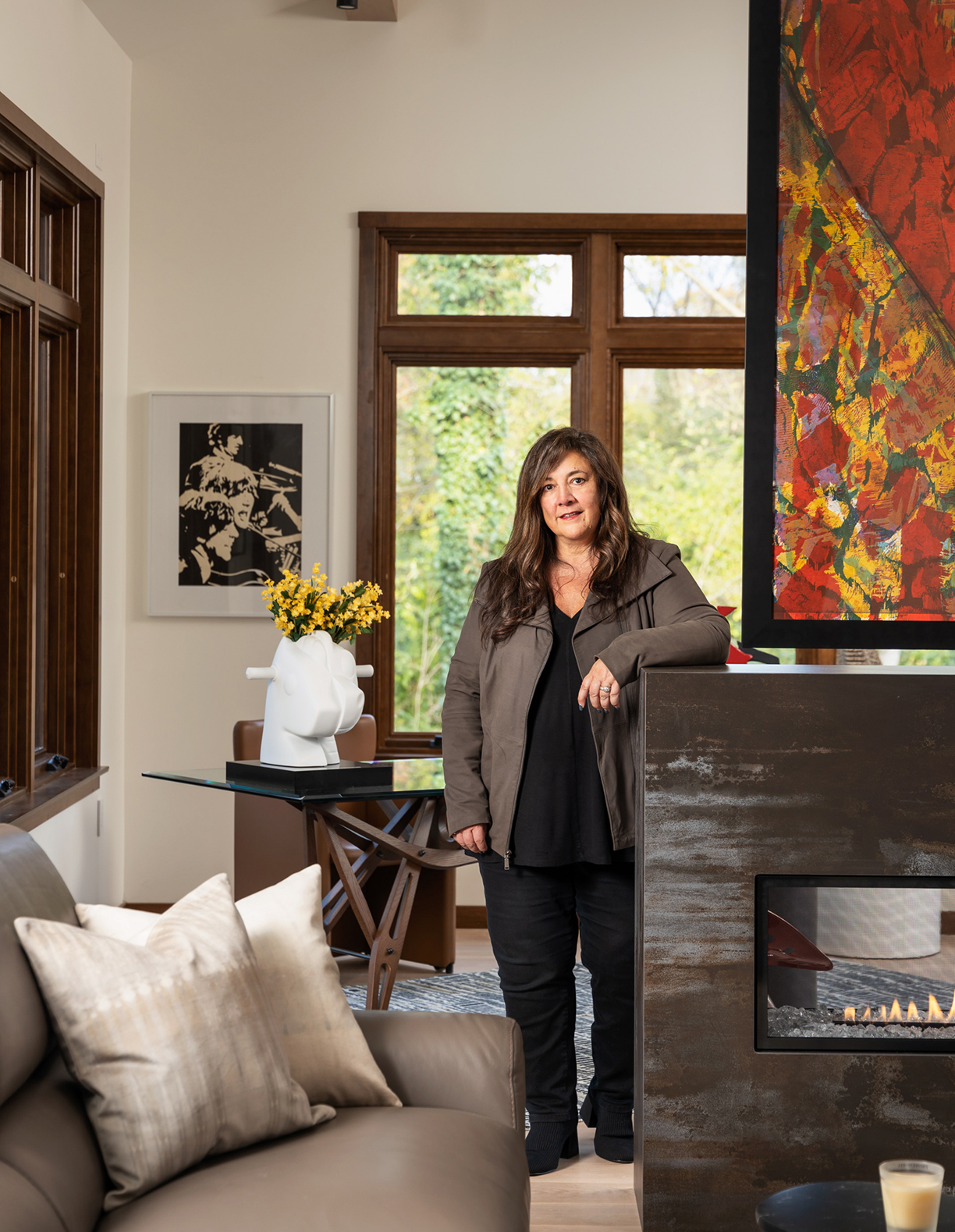
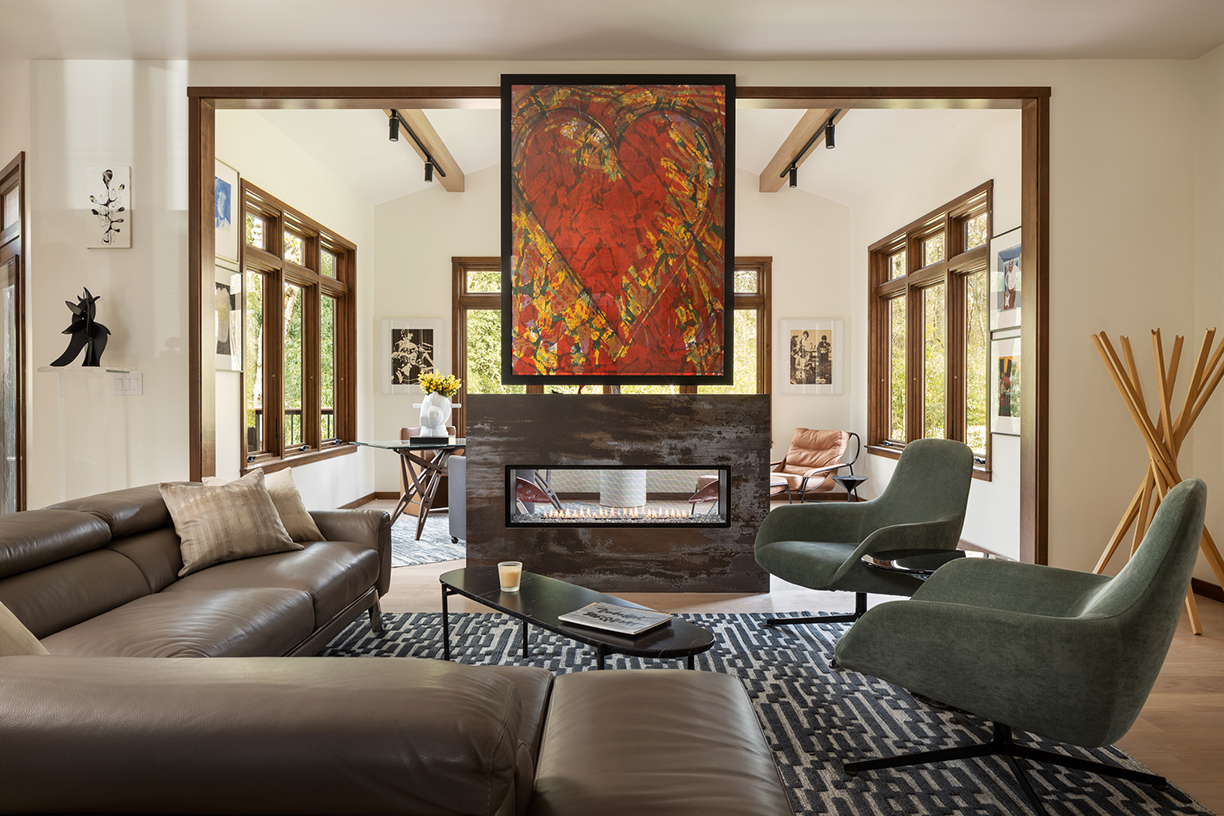
Photography by Mike Von Tassell Photography
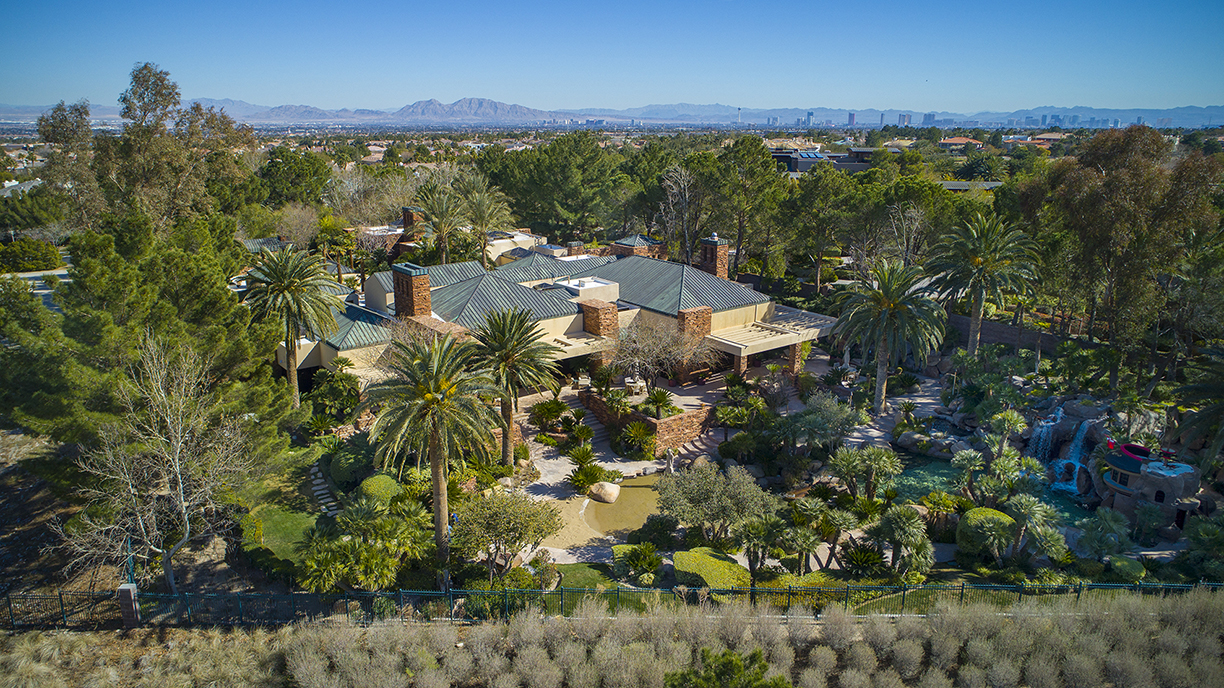
1701 Enclave Court
Las Vegas, Nevada 89134
Inspired by Frank Lloyd Wright’s Falling Water, this legacy property located in the prestigious Enclave of Summerlin is perfect for entertaining guests and family. Comprised of over 2,200 tons of ledge stone, this 13,000-plus-square-foot home sits on 2 acres of the private TPC course. This home’s amazing gardens and waterfalls run throughout the property, and not only serve as the centerpiece of this palatial home but provide a constant reminder of the true uniqueness of this home in the desert. Impressive vaulted-box, exposed-beam ceilings with recessed lighting adorn much of the home. For entertaining guests and family, this home boasts a great room, family room, formal dining room, wet bar, and wine cellar/home theater. This Las Vegas home offers both character and significance unmatched in the valley.
For more information, contact:
Don Kuhl
Principal – KUHL Group
Synergy | Sotheby’s International Realty
C: 702.324.2121 O: 702.360.1414

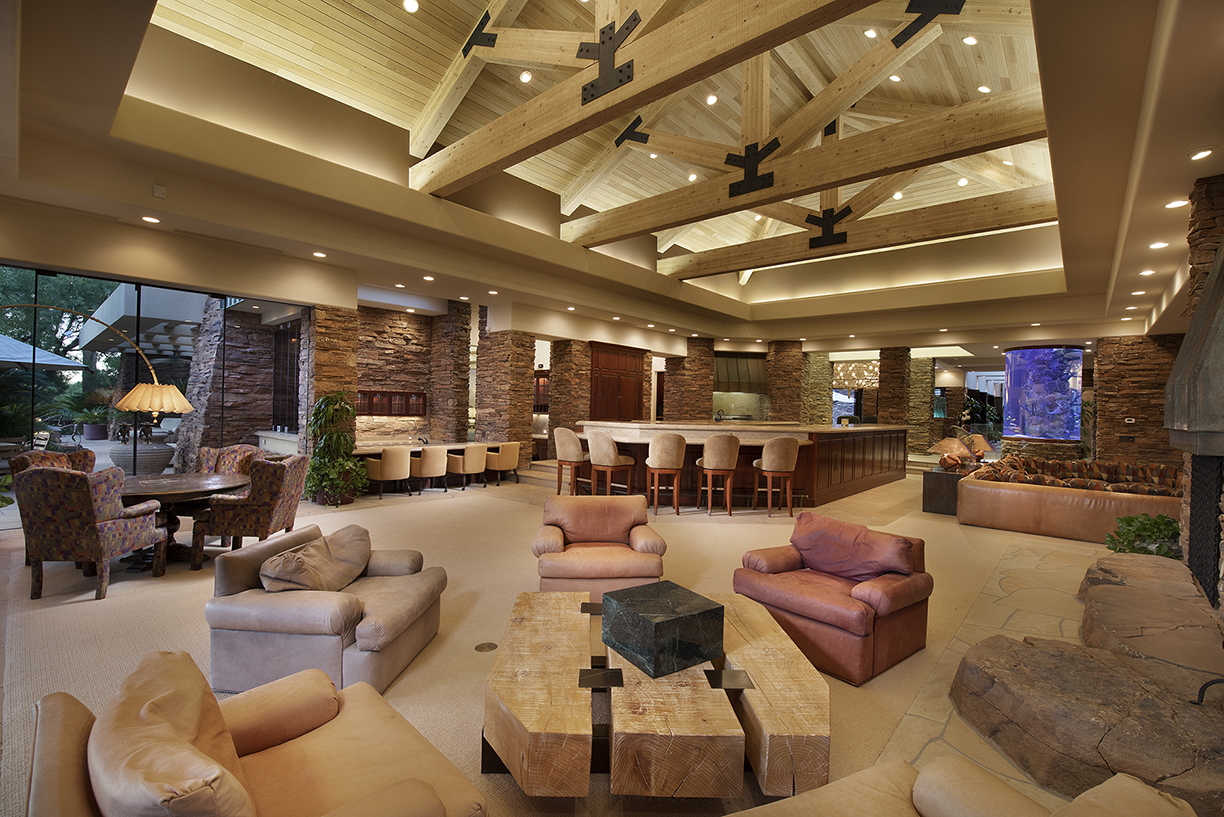
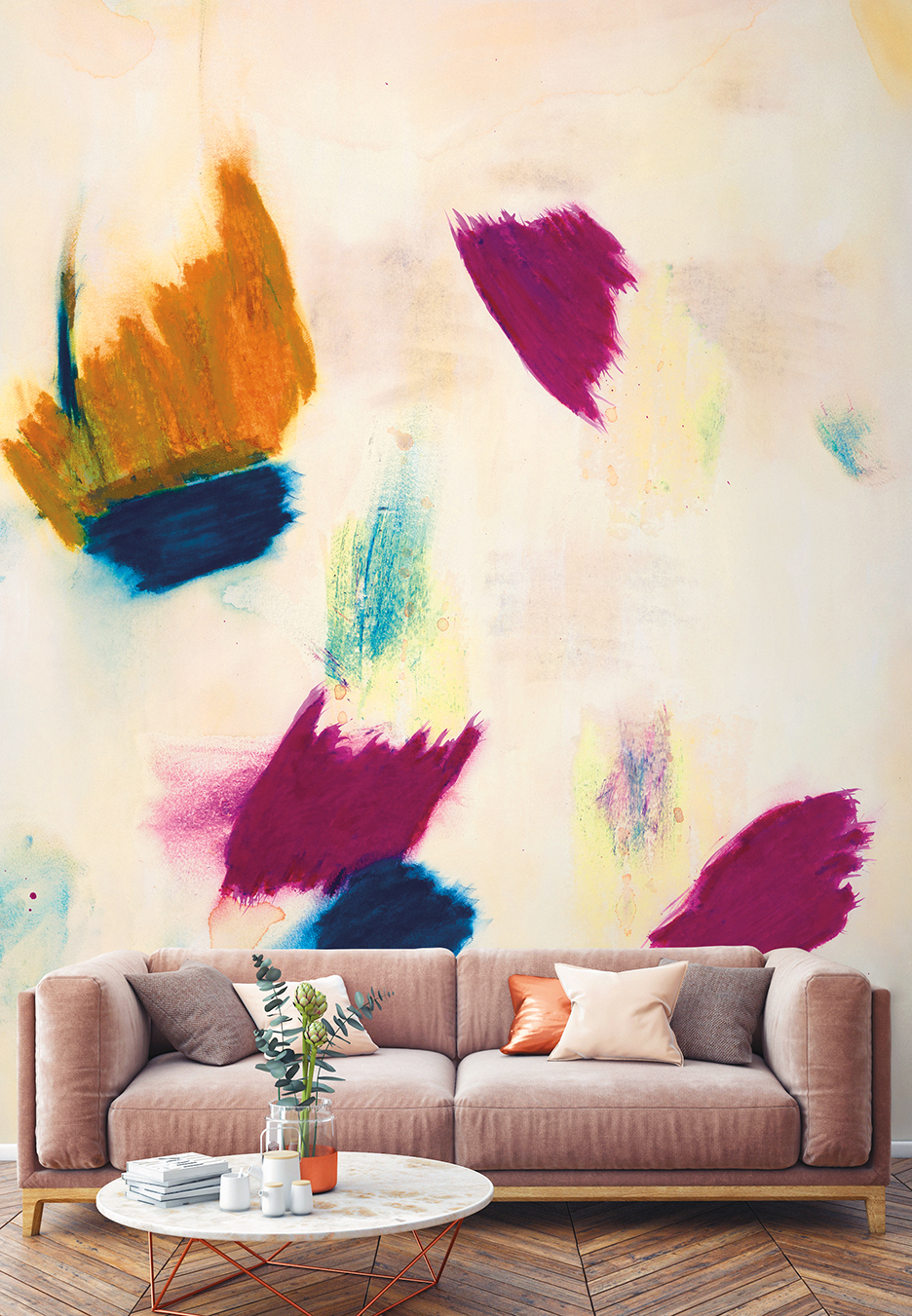
Arabella by Tempaper. Photo courtesy of Tempaper.
Penchants usually gravitate to the latest and greatest, but one tried and true material continues to be a magical catalyst for lifestyle.
Subtle or bold, classic or contemporary, shiny or opaque, wallpaper has evolved to be design’s magic wand — able to add pizzazz, lend a mellow undertone or inject just the right touch of coziness to any room.
Uniquely versatile, it enables consumers to fashion an interior that captures their individuality. It allows for unlimited customization as well as the creation of personalized living spaces, even adapting for children and pets without compromising on aesthetics. And for every budget from DIY to bespoke, there is a product.
“People want to LOVE their home. They want comfort and convenience, but do not want to sacrifice chic,” says San Francisco designer Jay Jeffers.
“There is a strong desire among consumers for original, authentic design that goes along with their vision for their house,” explains Joyce Romanoff, CEO of Maya Romanoff, a manufacturer of luxury wall coverings.
Ask designers about wallpaper and they invariably chorus, “it’s not your grandmother’s wallpaper,” a truism heard so frequently that it’s almost become a cliché. What is truly amazing is how much wallpaper ends up in homes today, adding a visual depth impossible to achieve with paint. Murals are back. So are individual walls showcased with a stunning texture or print.
And walls are only the beginning of today’s wallpaper story. “Trends indicate that the consumer is looking to personalize space through the creative use of wallpapers beyond the walls. Backings for bookcases, shelves, customized furnishings and ceilings all enter the realms of possibility.
While full room wraps, murals and feature walls still dominate the world of captivating designer installations, these small impact pieces allow for strong style statements without huge pattern or space commitments,” explains Carol Miller, content marketing manager for York Wallcoverings, a manufacturer with 125 years of innovation.
If the mention of wallpaper conjures visions of the flat, one-dimensional rolls common little more than 10 years ago, it’s time to refresh that image. “For many years wallpaper was something many of our clients avoided, but today, it is being rediscovered as an exciting way to introduce the color and patterns many homeowners are now embracing. And there are more wallpaper options out there than ever, thanks to advances in technology,” shares Elissa Morgante, founding partner of Chicago architecture and design firm Morgante-Wilson.
Dating back to decorated rice paper in China as early as 200 B.C., wallpaper has a long history that continues to evolve, with each century, each decade, adding innovations in materials, finishes, production methods and artistry. The most recent reinvention of wallpaper began more than a decade ago, but changes over the last few years have been especially remarkable. Old-school techniques such as block printing and silk screening continue, but the end result seems entirely new. Modern machinery creates precise designs, and new dyes impart richer vibrant hues. Diverse materials from wood and sand to crystals, shells, fibers, beads, even glass add depth.
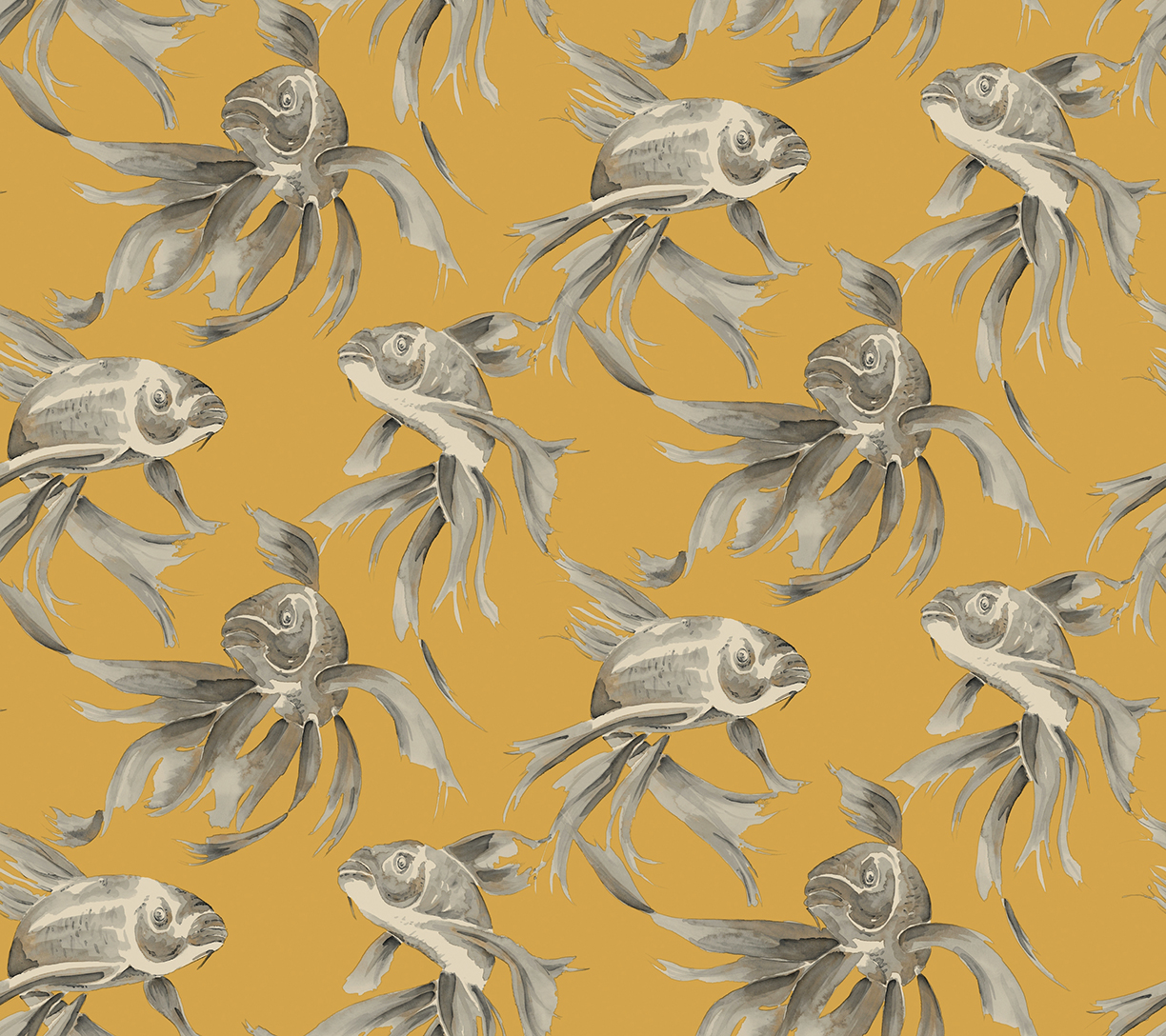
Left: Jewel Tones; Middle: Metallic; Right: Soft Organic
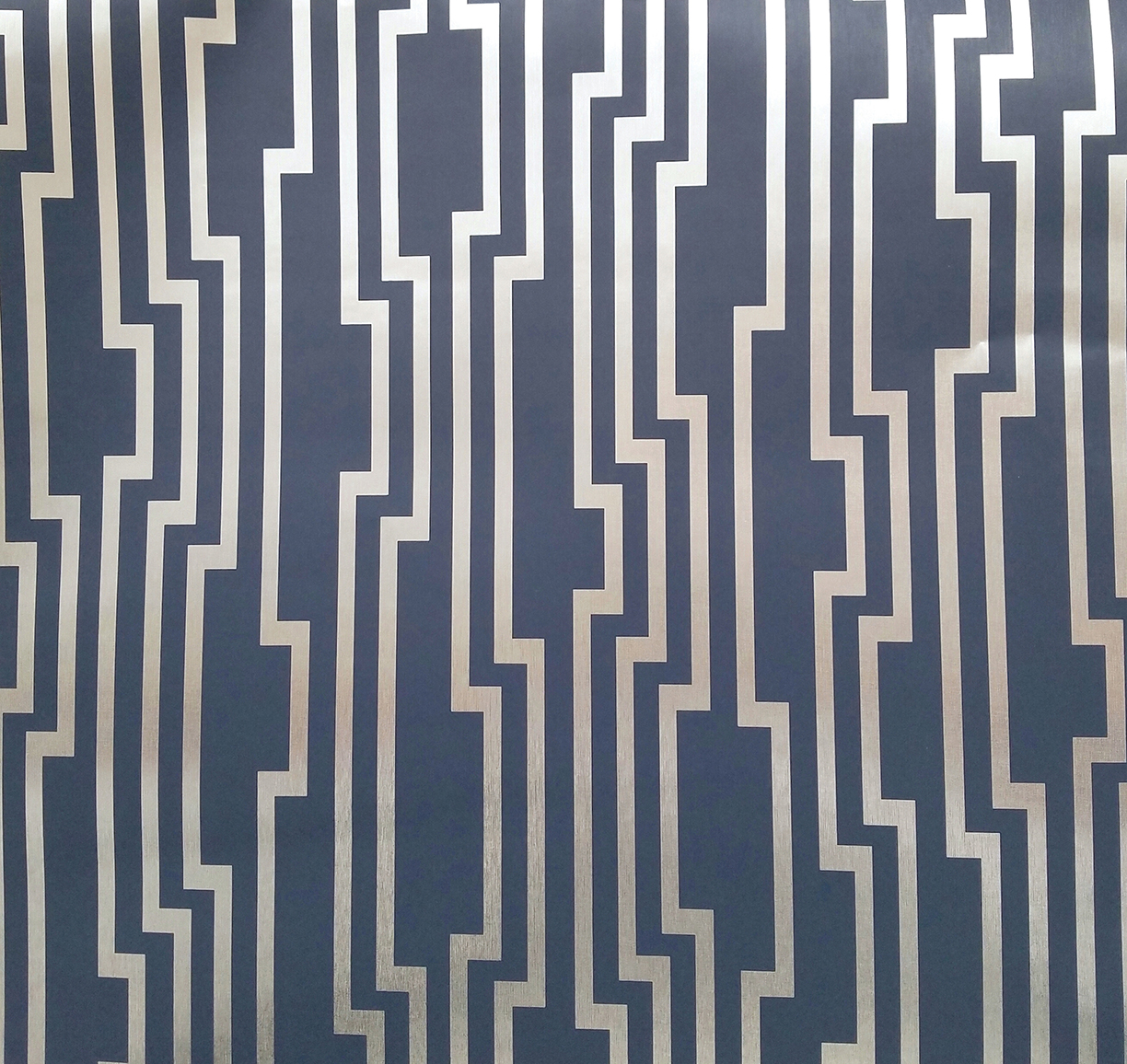
Wallpaper sample photos courtesy York Wallcoverings.
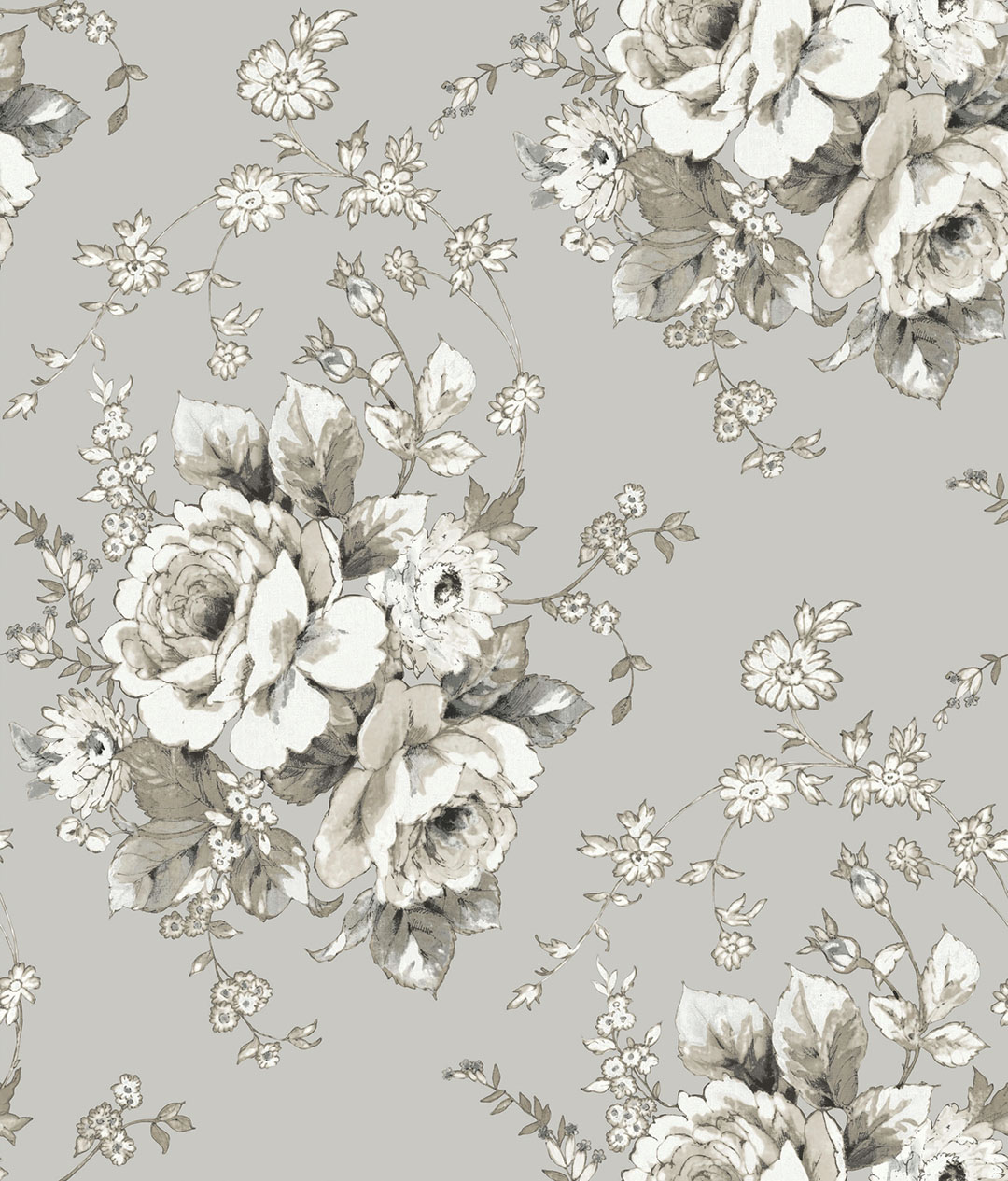
“Manufacturers can now digitally create the beautiful, luxurious look of expensive hand-painted or hand-blocked papers, or embed wallpapers with materials such as mica, glass beads, or even capiz shells to add interest and texture,” says Morgante.
“Over the last decade, we have diversified our product mix by expanding the types of materials we use. We have focused on making our processes more efficient, cost-effective and sustainable, while maintaining our handcraft and luxury appeal,” explains David Berkowitz, EVP of product development at Maya Romanoff, the largest manufacturer of handcrafted wall coverings in the U.S. Their gallery includes wool, burlap, silk and other natural fibers as well as precious metals and wood. Designs are often intricate, requiring an artisan’s touch. For example, papers in the precious metals collection often employ a time-honored method in which metallic leaves are hand applied to a paper backing with chopsticks. An ultra-modern topcoat prevents tarnishing or oxidizing, allowing for easier maintenance.
Textural papers continue to be in demand. The effect can be rustic or refined. In addition to traditional hemp, jute, sea grass, bamboo and raffia, grass cloth might integrate a variety of other materials. Additionally, says K. Tyler, partner and designer at Morgante Wilson, there are woven papers that look like linen on the wall or a variation of silk.
Schemes inspired by traditional designs (dare we mention chintz) have returned, but today’s execution is nothing like the dingy muted tones of yesteryear. Colors are vibrant, often using multiple shades of the same hue. Botanicals have also blossomed into an important trend, inspired by a growing passion for nature and biophilia. Look for splashy leaves and fronds or impressionist-inspired trees and flowers in soft tones. “I am also seeing a change from the crisp, bold large-scale patterns into a more abstract brush-stroked look. But with some of these styles, you’ll need to be aware you won’t have a side match, and each panel is distinguished,” says Christopher Grubb, president of Arch-Interiors Design Group in Beverly Hills.
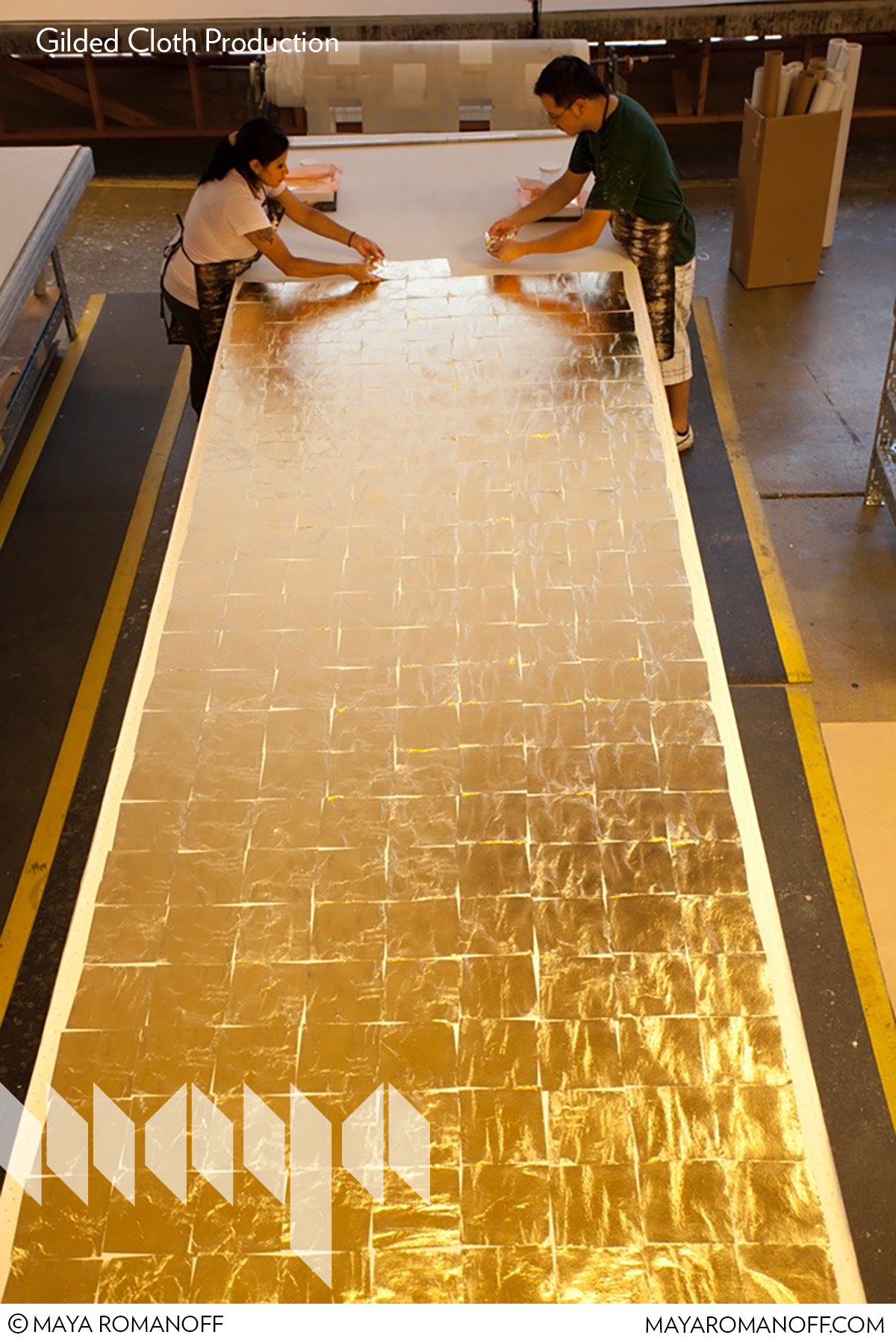
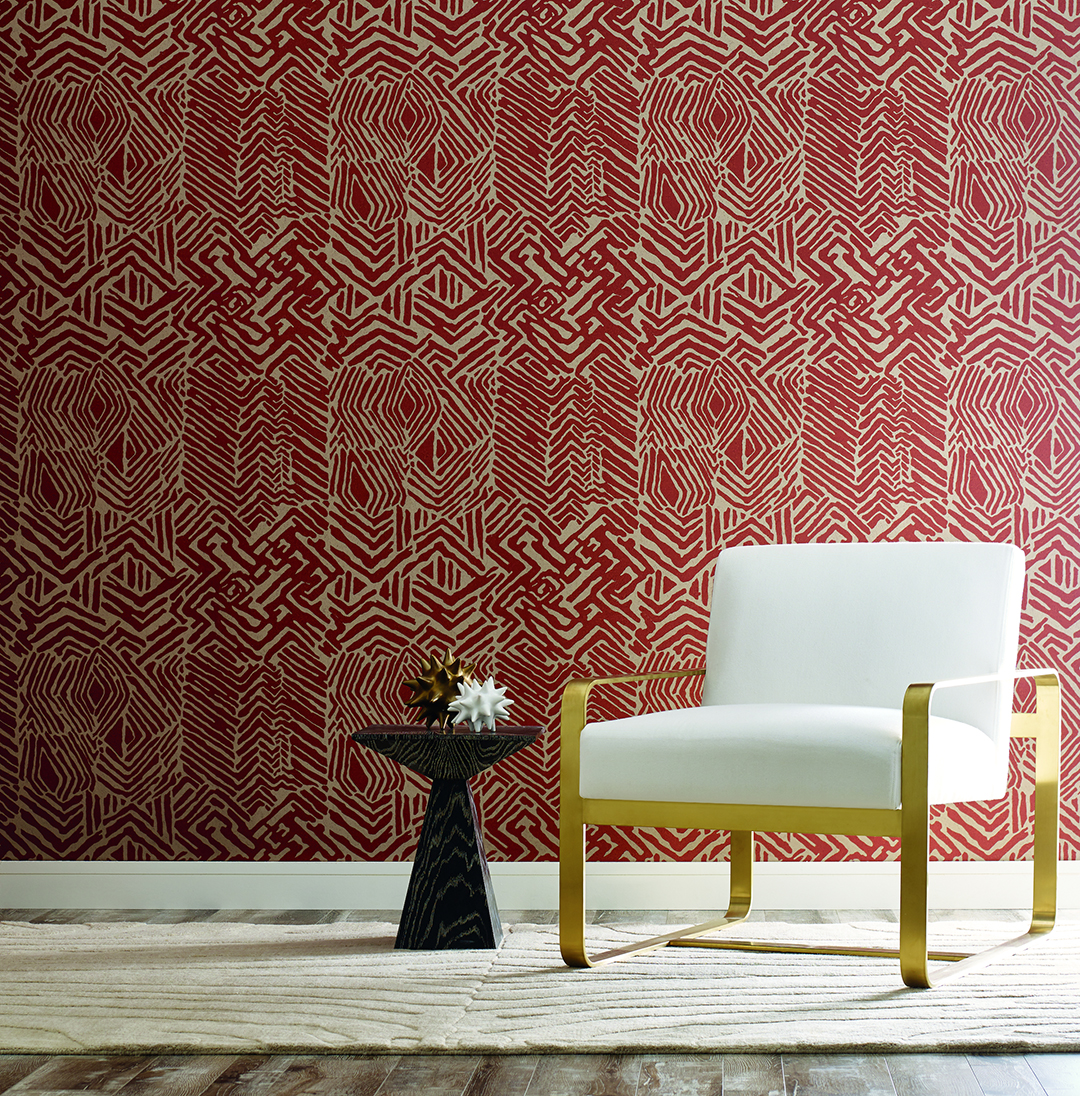
Top left: Precious metal inlaid; Top right: Hand-finished wood veneer, Ajiro Fanfare. Bottom: Tribal Print from Ronald Redding Handcrafted Naturals collection.
Photos of wallpaper production and sample by Maya Romanoff.
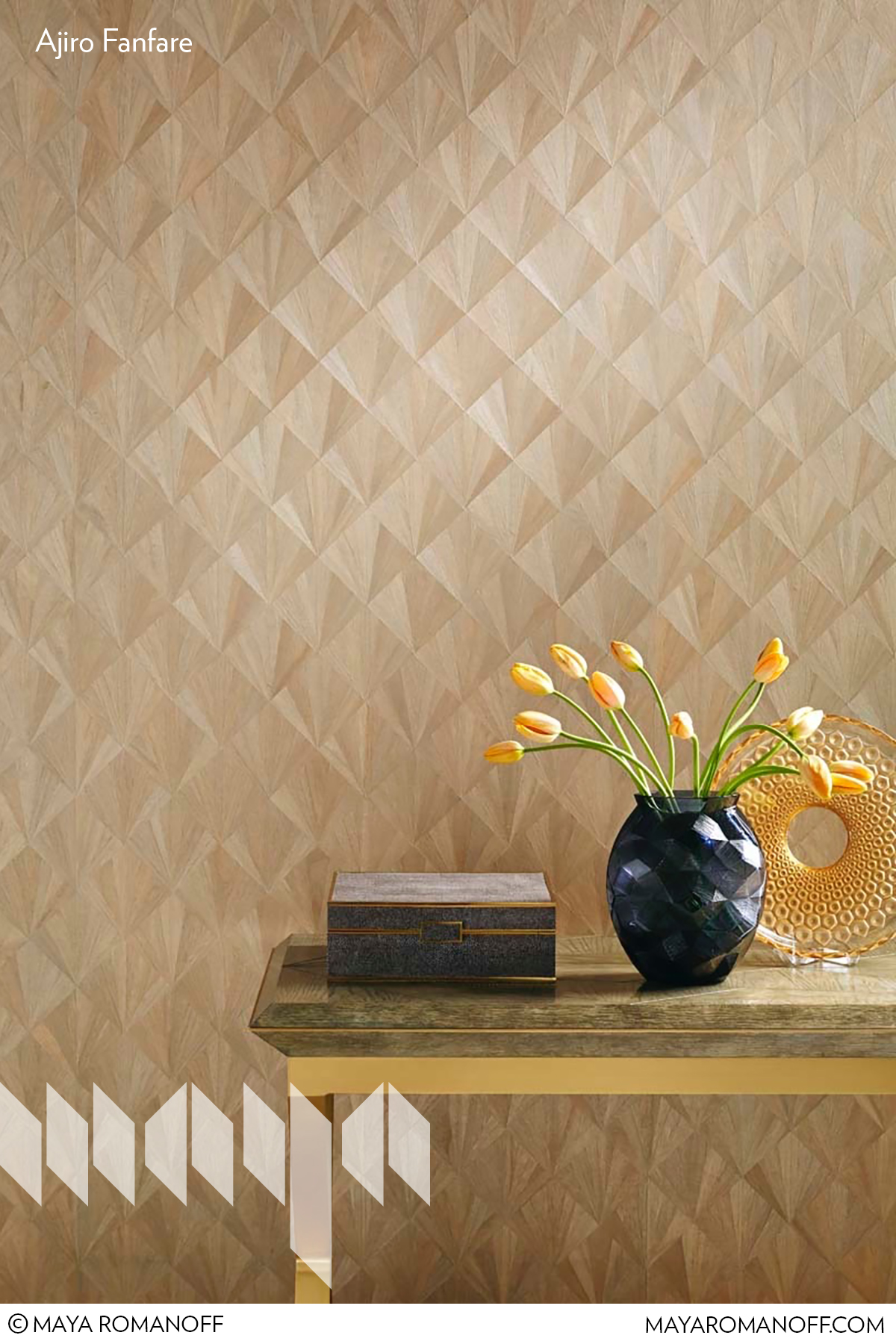
“There are so many things technology has allowed us to do today. We can do wall covering now that looks like the real material, but it’s made out of vinyl,” says Tony Sutton, owner of Est Est, Inc., an award-winning design firm in Scottsdale. Sutton illustrates with examples of wallpaper made from ultra-thin cork or micro-layers of slate. Additionally, he says, “I can take any photograph and then make a giant custom wallpaper out of it.”
Options today range from rugged vinyls to bespoke designs and hand-painted silks with prices that can exceed $1,000 a roll. “Vinyls are typically less expensive, but super durable. Many of them are rated for commercial use and sold in wider widths,” says Mondi.
“I am a huge fan of using vinyl wall coverings,” says Grubb, who does commercial as well as residential projects. “The color palette is enormous. There are silk and grass cloth looks, wovens, textures and embossed patterns. It’s incredibly durable and easy to maintain.”
“On the other end of the spectrum, you would find hand-painted wall coverings. There are custom made, high-end and truly artisan products that typically replicate a faux finish or mural. In between is where most wallpapers reside. Digital printing is typically very affordable and can often be done on different background materials,” says Mondi.
Design is only part of what consumers want. Sustainability and ease of use are equally important. Upmarket to DIY consumers demand sustainability, which includes efforts to minimize the footprint of manufacturing, observes Miller. Beyond no VOCs, ozone-depleting chemicals or cadmium or mercury, York Wallcoverings also uses water-based inks and coatings and smokeless, non-polluting inks. Additionally, there is a push toward sustainable materials, including cork, natural grasses, leaves, wood veneer, even glass beads made from recycled windshield glass.
Ease of Use
“Now every level and type of wallpaper concerns itself with ease of application and removability,” says Miller. “Even nonwoven unpasted backings used most often by designers remove in full strips.”
A potential game-changer for the industry came with Tempaper, which has revolutionized the concept of peel and stick papers. There is nothing stodgy about these designs, which run the gamut from traditional classics such as chinoiserie to glam to bohemian. They also tap into creations by well-known designers such as Bobby Berk and Genevieve Gorder. The company also offers panels and murals as large as 8 feet by 10 feet. Some designs such as Arabella, part of the Zoe Bios collection, are inspired by artists such as Jean Michel Basquiat.
Founded by twin sisters Jennifer Matthews and Julia Au, Tempaper is an ideal solution for someone renting, as designer Jewel Marlowe discovered. “Recently we rented a high-end beach home in Jamestown, Rhode Island, for 10 months. This was just long enough that I wanted to add some personality to some of the spaces in order for it to feel like home. However, I was very aware that whatever I used needed to be quickly removable. Luckily, I found some beautiful Tempaper designs to personalize and beautify some of our rooms,” she shares.
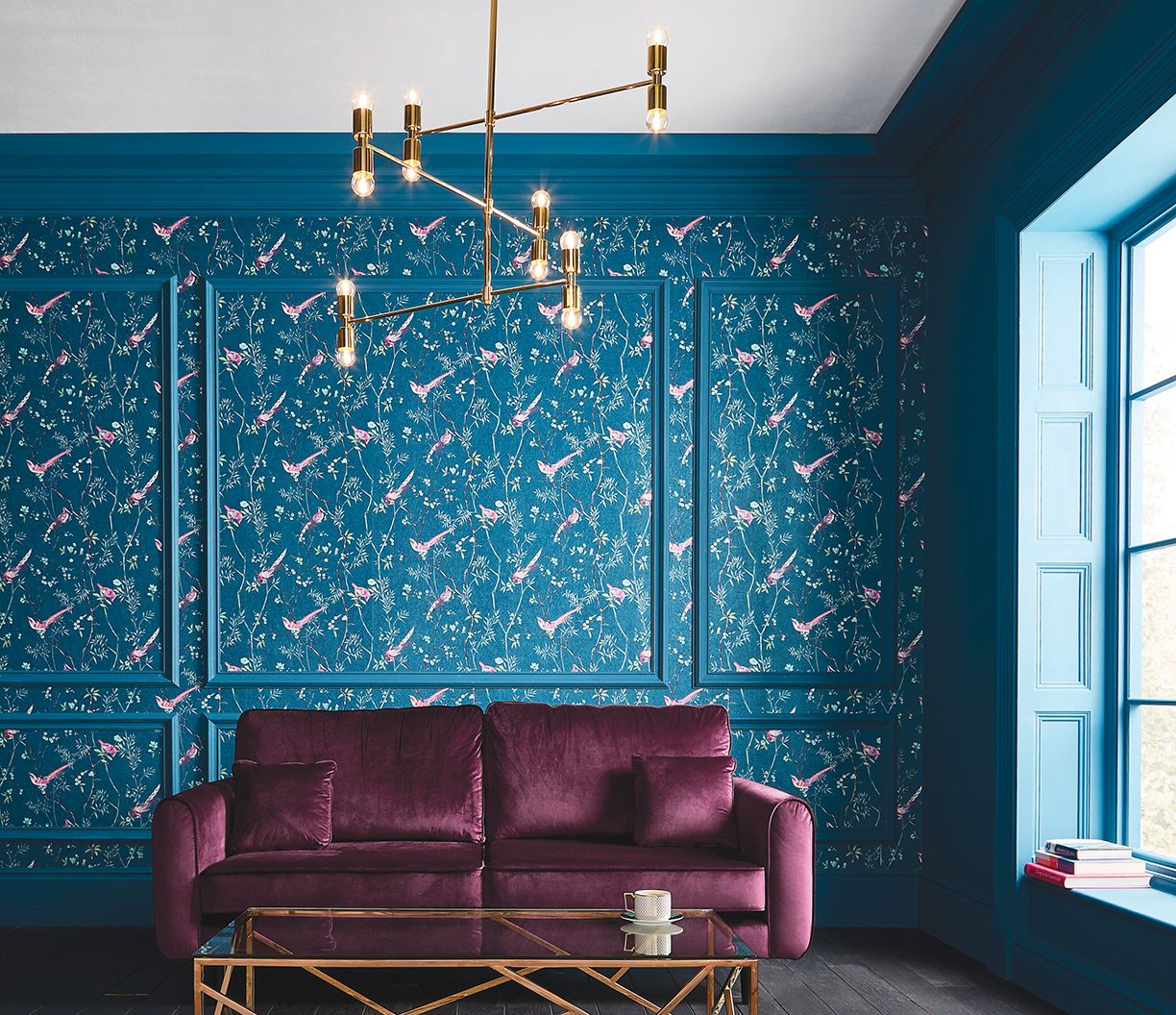
Birds are flocking to wallpaper this year. Graham & Brownexpresses this theme in Tori Teal.
Photos courtesy of Graham & Brown.
New additions to Tempaper’s line up include designs from Wright Kitchen and holographic decals from Bobby Berk. This year, the company also introduced a collection of vinyl floor rugs.
Tempaper does seem to add a “now you see it, now you don’t” ability to wallpaper’s extensive resume, making it a truly magical material.
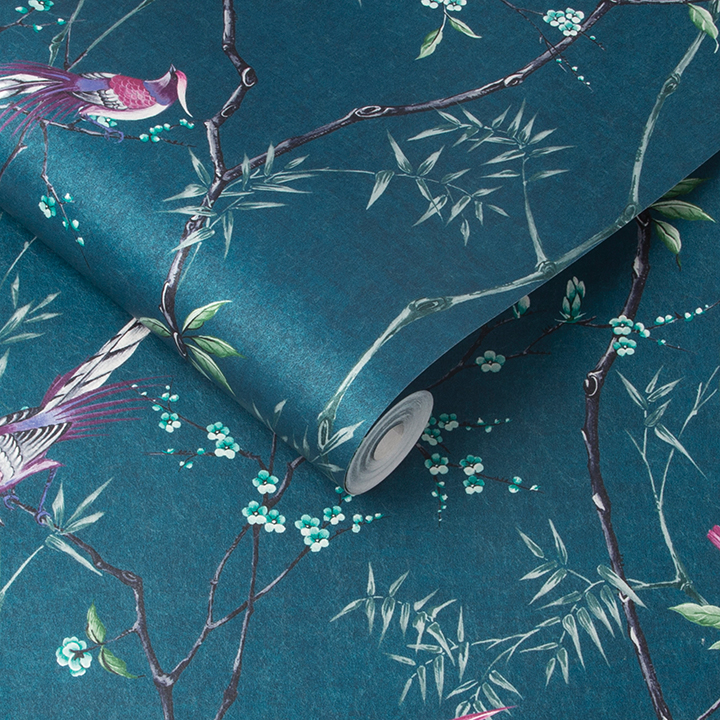
When it comes to kitchens, the popularity of all things smart and sanitary is soaring, as consumers gravitate toward antimicrobial features.
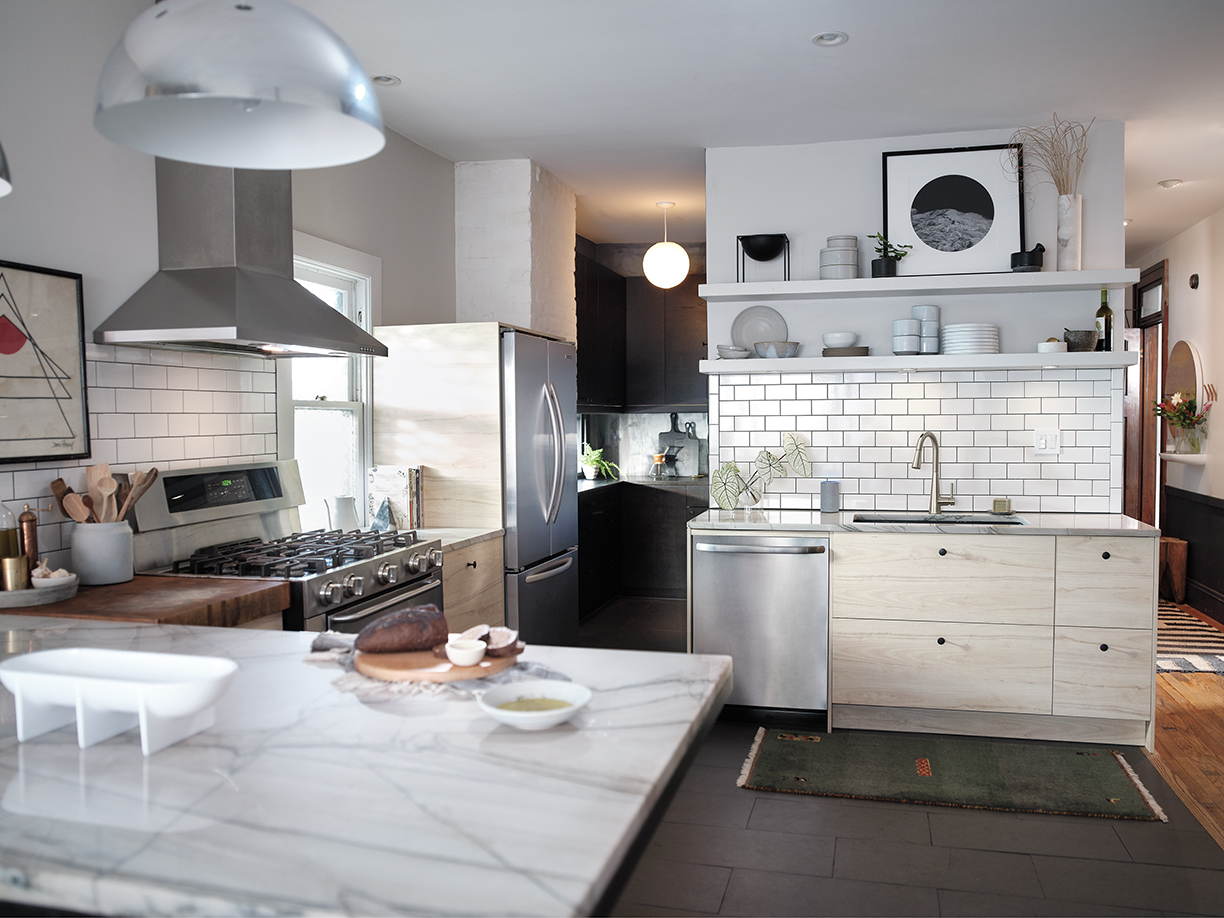
Almost a sous chef, innovative, hands-free faucets such as U by Moen fill pots with exact amounts of hot or cold water or anything in between.
Seemingly overnight, touchless faucets, easy-open drawers and an ever-growing array of kitchen tech morphed from “nice-to-have” amenities to “must-haves” as the desire for cleanliness and safety eclipsed convenience.
Indoor air quality, purified water and clean surfaces rank high with consumers. Before the pandemic, interest in wellness at home was on the rise; now, amenities that bring a hygienic benefit, particularly in the kitchen, top wellness demands. A desire for simplification with easy-to-clean cabinets and counters along with healthy living are micro themes expected to steer product development and design in the future, according to the National Kitchen and Bath Association.
Even trusted materials such as wood, cork and brass are now considered for their capacity to shed germs or resist contamination. “All our faucets are solid brass construction and therefore, by the very nature of the metal, have additional antimicrobial properties,” points out Noah Taft, senior vice president of marketing and sales at California Faucets, noting the benefit of brass over less costly materials

Pure Water
As the desire for healthy homes builds, so does interest in water quality. Filtration has become an important focus, according to experts at Kohler, who say more than 75 percent of customers already take measures to filter their drinking water. In January, Kohler introduced a four-stage reverse osmosis purification system designed to fit in the cabinet under the kitchen sink. The system reduces contaminants, including lead, mercury, chlorine, bacteria, virus, arsenic, copper, fluoride and more. With a capacity of 27.5 gallons per day, it would replace approximately 200, 16.9 oz. bottles of water.
Water Appliance
Sinks used to be, well, just sinks, until Rohl and other manufacturers elevated the status to “water appliance.” According to estimates, the kitchen sink used to be frequented 10 to 30 times a day. Now, after weeks of sheltering at home and a hyper-focus on handwashing, the sink is getting more use than ever and receiving lots of scrutiny regarding design, ease of use and even appearance.
“Kitchen sinks and faucets are on the front lines of keeping a home clean and safe — used continuously for food preparation, hand and dishwashing,” says Edyta Drutis, director, brand and communications, at Blanco North America. Blanco’s Silgranit stone-like sink material is nonporous, resistant to stains, scratches, chips, acid and heat. Acting as a shield against dirt and contaminants, it reduces bacterial growth by 98 percent. The hydrophobic surface pushes away dirt and water, so it drains easily and cleans with soap and water or baking soda.
When it comes to sinks, bigger continues to be better. Even before the pandemic, experts at the National Kitchen and Bath Association noted increased demand for large sinks to accommodate tasks as diverse as washing fresh produce and jumbo pans, to babies and the
occasional pup.
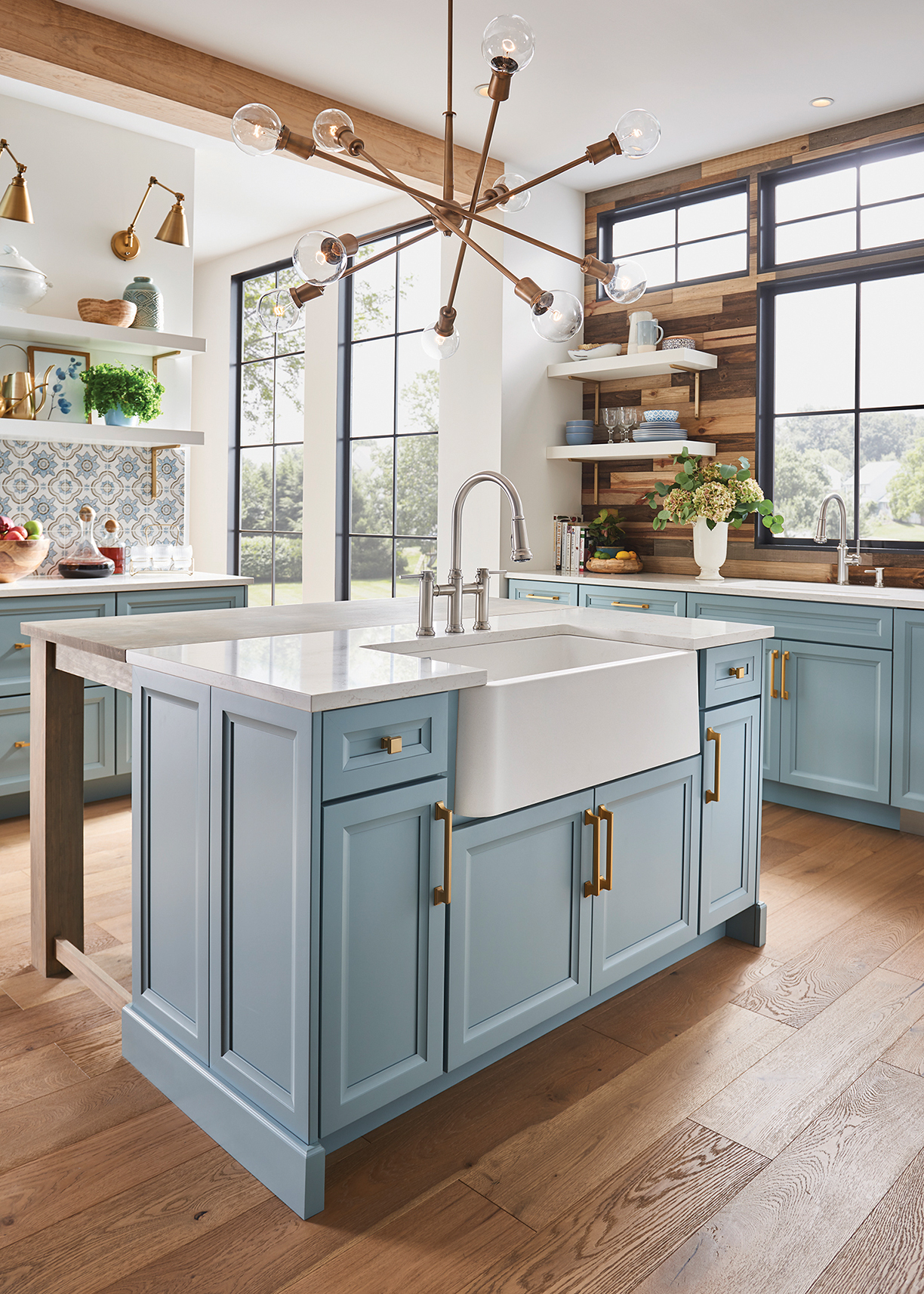
More Power Per Drop
Look for faucets designed to do more than deliver water. Lenova introduced a model that takes washing produce or the dog’s bowl to the next level by integrating ozone into the flow. Recognized as a safe, non-toxic way to kill viruses, bacteria, mold, yeast and algae within seconds of contact, aqueous ozone has been extensively tested and clinically proven, according to Lenova. Not only does it sanitize surfaces, but it can be used to wash produce, and it even removes pesticides.
Adding more cleaning power to each drop, particularly for sprays, is another objective for manufacturers. Kohler recently introduced options such as a faucet sprayer with nozzles aligned to create a forceful blade of water to sweep away stuck-on food. Another, a soft spray, preps berries without bruising. Moen optimized its sprays to deliver 50 percent more spray power while containing the splash — great for messy pots and messy hands.
Look Ma, No Hands!
Touch-free faucets have been around for a few years. In the first versions, sensors would activate the flow in response to a motion. Then, voice control was added. The most recent innovation enables homeowners to activate faucets via Alexa or Google Home. Turning the water on and off is only part of what U by Moen — a Best of KBIS 2020 winner — delivers. Instead, it can fill a baby bottle with just the right amount of water at the right temperature or load a pasta pot with precisely four quarts of hot water, freeing the cook for other tasks. Metered dispensing ranges from one tablespoon to 15 gallons, and temperature commands can be exact degrees or merely hot or cold. “Baby bottle” and other customizable presets simplify commands.
Hard As Glass
“Glass tiles are not porous and do not possess characteristics that allow or promote the growth or life of microbes, bacteria, or germs,” explains Jim Stevens, brand manager for Lunada Bay Tile. “Keep in mind that the grout between each tile is porous and does not have these same characteristics. However, grout is usually set down, below the top surface of the tiles, so direct contact is less likely. And grout could be sealed with an antimicrobial sealer to create a safe and sanitary surface.”
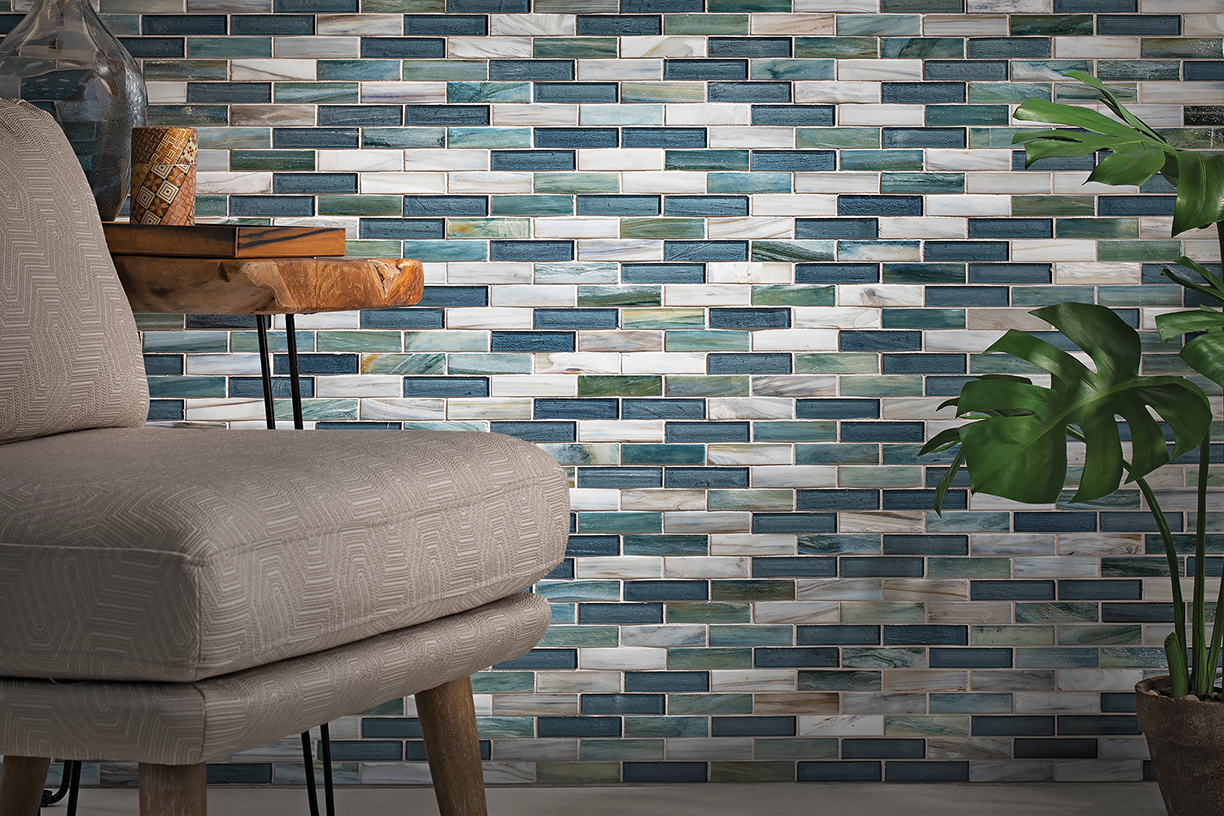
Glass tiles, which are nonporous, also mesmerize.
The trends changing houses in 2020 and beyond.
By Camilla McLaughlin
New values, shifting demographics and technology are all transformative agents in 2020, and each will shape real estate and design well into the next decade. Some, such as outdoor living, are not new, while others, including the importance of ancillary spaces or a desire for slightly smaller but highly customized homes, are just getting underway. Farmhouse is out; contemporary, along with modern interpretations of traditional styles, is finding favor with architects and home buyers. Attitudes about what’s important in a home beyond an open floorplan, and even the open concept itself, are being reconsidered and revised. Color is back. Experts tell us the passion for grey and all-white kitchens is waning, although in practice designers also say neutrals still dominate.
Got all of that?
Even the term “move-up buyer” has a new meaning. “Move up doesn’t necessarily mean move into a bigger home as it did for previous generation,” explains Leigh Spicher, national director of design studios for Ashton Woods. “Today’s move up buyers expect quality and are willing to invest in special features in their home.” For upscale owners, preferences are likely to lean toward diversification in favor of several properties in different locations rather than a large estate home.
Each year, The Best in American Living program (BALA), an annual design competition held by the National Association of Home Builders, showcases award-winning design and architecture and pinpoints current and growing trends. Awards this year, based on homes built in 2019, showcased a range of styles from midcentury modern to transitional to contemporary expressions rooted in traditional styles or regional aesthetics.
Another change, according to Don Ruthro , principal at Dahlin Group Architecture Planning and this year’s judging chair, is more homes with the same style inside and out, which he says conveys a greater sense of authenticity.
Even in production homes architects are pushing for more character and uniqueness with thoughtful, well edited design elements. Well edited, according to BALA, means a genuine purpose of place and points of interest that draw the eye across the facade without all of the fussiness of past decades.
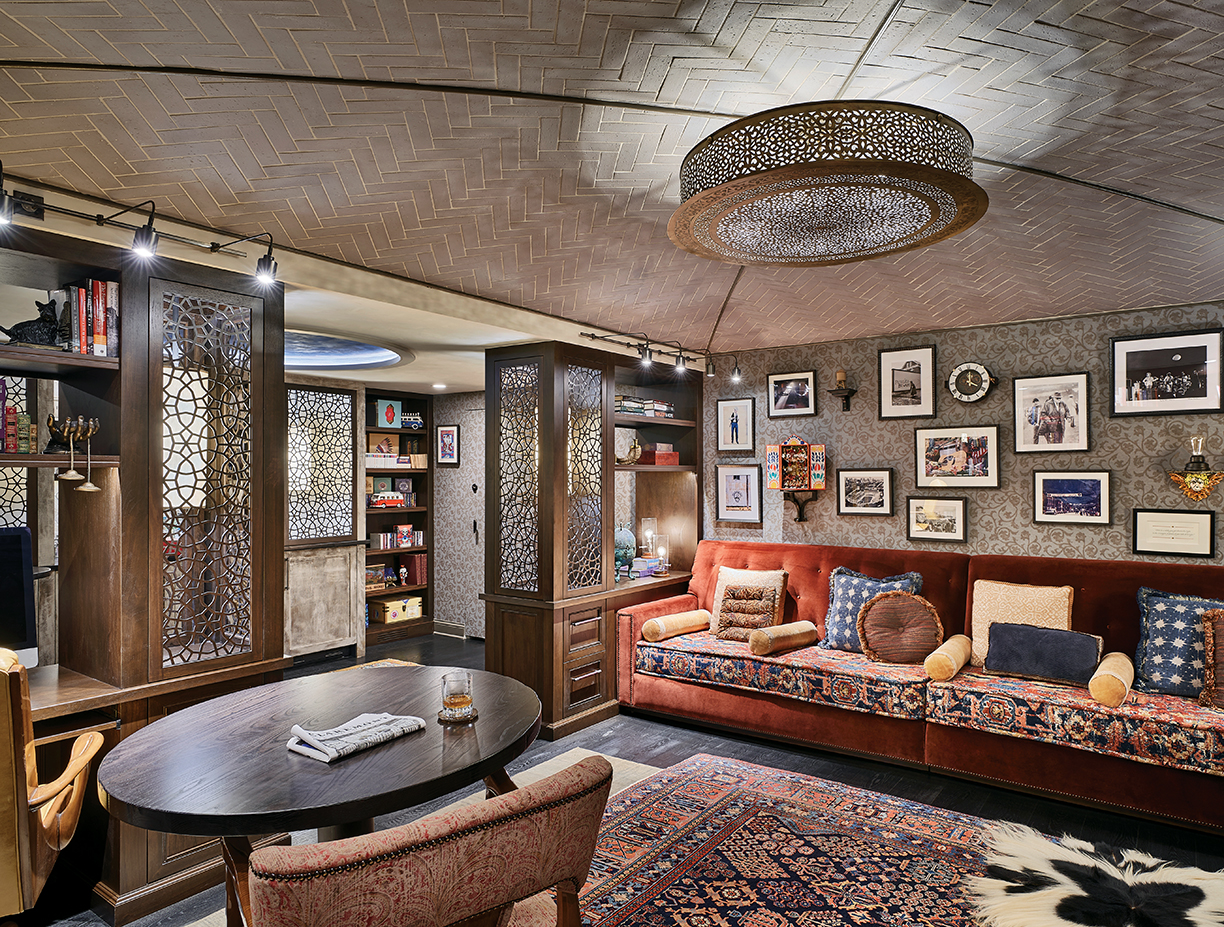
Curated design details are another design trend BALA judges highlight. “It’s clear that buyers want their home to feel personalized to their taste. From ceiling textures to shelving choices to mullion size. Every detail matters, and today’s educated buyers won’t settle for anything less,” they explain.
Other trends play into the desire for personalization. Anything that adds texture is on trend, especially wallpaper. Also enhancing personalization are unique applications of wood to highlight forms and also warm up interiors. Compared to prior years, the use of wood, often a dark hue with a matt fi nish, mixed with other surfaces, was very much in evidence in homes, new and remodeled, constructed to showcase current trends at the International Builders Show. Adding to the depth created by an overlay of textures in a home is the use of mixed metal finishes, with gold tones very much in evidence.
No facets of design are left to chance or convenience, even lighting. “Like other design details, just installing what’s on hand without added thought about placement just won’t fly with the 2020 buyer,” further advise BALA judges. Curated design details, personalized lighting design and texture were all highlighted as trends buyers can expect to see in homes over the next few years.
Even though kitchen, great room and dining — casual or formal — combined into a central living space continues to dominate, how that space is organized and expressed in an overall fl oorplan is slowly evolving. “Open space plans for the family room, kitchen, and dining area are still going strong. Our challenge in open plans is how to defi ne each space and give it some separation while still maintaining the overall open feel,” says Chicago designer Donna Mondi.
In California, designer Christine Markatos Lowe says the open plan is going strong, and perhaps the biggest change has been the addition of a second functional space to kitchens. For higherpriced homes, the presence of a back kitchen, whether a full-blown kitchen, a large walk in pantry or a butler’s pantry, has become a must have, central to keeping the main kitchen streamlined and clutter free.
Colorful kitchens? Maybe.
Examples at the national kitchen and bath industry show refl ected forecasts calling for color to punch up kitchens. Dark blues and earthy greens combined with wood finishes often clad lower cabinets and islands. Still, a number of designers express reservations regarding too much color. Wood cabinets continue to be on trend, mixed with other finishes.
“There has been a shift back into furniture-style cabinetry, exposed appliances (there’s always a place for LaCornue!), and especially statement marble countertops. European influences have made their way into the modern kitchen and I couldn’t be happier,” adds Mondi.
Another trend in renovations, Lowe says, is to open sightlines so rooms feel more connected to each other but still have their own language. “So it’s a combination of both things we’re seeing.”
“The main living spaces are getting bigger and more integrated with each other, but a good architect will design in such a way so they feel like individual spaces even though it’s part of one room,” says Bob Zuber, AIA, who is a partner at Morgante Wilson Architects in Evanston, Illinois.
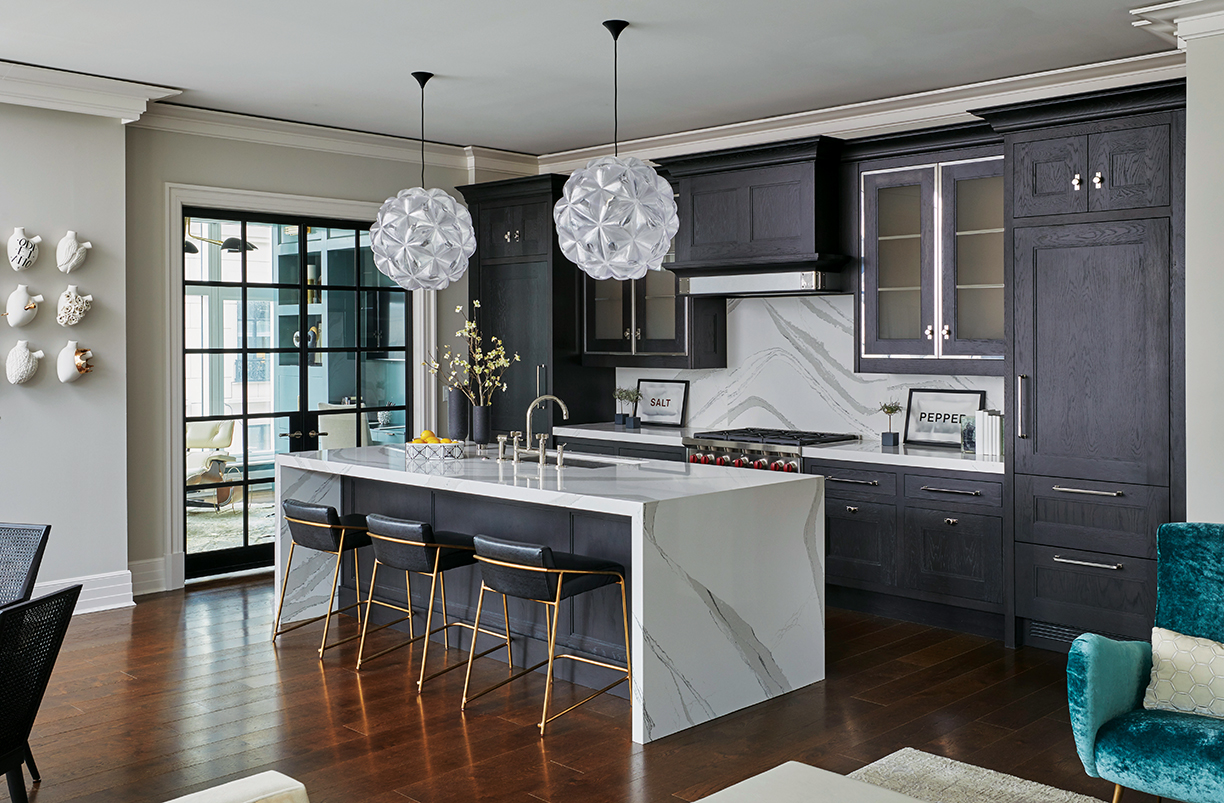
Tricked Out Extras
Chances are what makes a house special for most buyers is not the number of bedrooms or even a great open plan but extras, what K. Tyler, also a partner and head of Interior Design at Morgante Wilson, dubs ancillary spaces. From tricked out mudrooms and laundry rooms to glass-enclosed wine rooms to pantries and second kitchens, what might be extras are essentials to buyers often shaping a unique living experience and often tilting them in favor of a certain house or floorplan. Offices, dens and studies will continue to be important additions to open plans. Nine times out of 10, homes with these features are going to be preferred over ones that just have big rooms, says Tyler.
Signature front entries are also gaining prominence. Expect to see continued emphasis on front entries. Foyers are designed to be functional but also to make a dazzling first impression.
Preferences for these features and quality over square footage extend to a range of price brackets. According to the National Association of Home Builders annual survey of buyer preferences, more buyers overall are likely to choose less square foot but higher quality homes with desirable features such as large walk-in master closets and energy efficient windows and lighting over large homes with fewer features.
Innovative materials continue to be important change agents. Consider outdoor living, one of the most transformative trends of the last decade. The modest pool and patio is now an array of open air venues and outdoor rooms. Pools and fire features are equally artful and functional. Rather than just an amenity tacked on to the house, outdoor connections are now the main orientation and organizing element for plans. Transitions between the two are hardly noticeable thanks to new materials and finishes, extending flooring beyond interiors. Master bedrooms morph into full blown retreats with their own outdoor spaces.
Innovative plans further bring green spaces deep into the home via interior courtyards. Expect to see more ways to bridge inside with outside as the decade progresses. Most recently, super large panes of glass and larger glass doors, further enhance visual connections and light-filled interiors. In most regions of the country, an indoor/outdoor sync is considered a “must have” for luxury, and there are no indications the penchant for outdoor connections will diminish. Among BALA trends, expansive largeformat windows along with sophisticated indoor/outdoor connections figured prominently.
Thinking Long Term
Beginning with the recovery, the tenure of homeownership increased. Instead of the 4.21-year average, typical from 2000 to 2007, ownership extended to 8 years or longer, hitting a record high in the end of 2018, with some cities — Boston, San Francisco and Hartford — charting tenures of 10 years or more. Whether or not this is a trend worth watching or simply a blip on the charts remains to be seen, but it is a solid indicator of changing attitudes toward home that spills over into design, interiors, even furnishings. Increasingly owners in almost all price brackets are thinking long term and lifestyle when it comes to their homes.
Resale seems to have moved to the back burner. Instead, consumers look for features and fi nishes that uniquely sync with and enhance their lifestyle. “I would say people are tailoring the house more specifically towards they way they want to live,” explains Zuber, noting sometimes those same features will also enhance resale.
According to Ashton Woods’ 2020 design trends survey, 86 percent of today’s buyers said home personalization is important.
Another indication of consumers anticipating longer ownership is growing interest in fl exible spaces and also in accommodating a range of ages. The term flexible spaces is taking on a new meaning. Instead of extra footage for a mancave or teen hangout, it’s viewed as versatile rooms that can change over time, explains Spicher. Perhaps a nursery today and a home o ce tomorrow. Or as many owners (55 percent in Ashton Woods Design survey) say, space that can transform into additional living space in the future for an aging family member or boomerang children.
More clients even in the 40s are looking to use the house when they are older and are planning to these accommodations with wider doors and space for an elevator shaft, say Tyler and Zuber.
Smart Home Challenges
In the next decade, smart home technology will change homes more than any other factor. Already new homes beyond a certain price point include a range of apps and devices, particularly in the kitchens, where manufacturers are already adding connections among appliances such as the hood with a range top. Also, voice control. Some brands also incorporate technology that enables some repairs to be made remotely. “What’s exciting is that every passing second, we get one step closer to a context-aware smart home. Manufacturers are pushing the boundaries. Developments in the areas of sensing technology and AI will result in appliances, fi xtures and systems that automatically respond and adapt to our home and environment changes,” says Kate Bailey, senior director of Category Management at Ferguson Enterprises.
“It’s not so much about new things as it is about things getting smaller, faster, lighter better integrated, so they get to the point where smart becomes livable and something you want to put in your homes,” says Melissa Morman, client experience officer at Builders Digital Experience.
Looking ahead, the key, the most transformative feature will be the development of an operating system that will integrate diverse function which will enhance integration and connection of devices and enable a home to further adapt to changing conditions.
Also on the horizon is a desire for homes to be a nurturing center for wellness, a capability that will be enhanced by new technology.














